PART III
THREE COMPOSERS AND A SONG
4
William Billings (1746-1800) and American Psalmody: a Study of Musical Dissemination
William Billings is commonly taken as the American psalmodist of the eighteenth century. Self-taught, prolific, a patriot in politics, and blessed with original vision, both as a musician and a writer, Billings was the most famous New England composer of his age, and his reputation has long survived him. In his own day, he and his music were widely known and admired. When psalmodists and writers of his time chose one man to exemplify their tradition and serve as a ready point of reference, Billings was the natural choice. When nineteenth-century reformers wished to recall the supposedly crude, untutored beginnings of American music, Billings served their purposes too. More recently, when historians of American music have chronicled the beginnings of indigenous American composition, or when choirs have performed music of eighteenth-century New England, it is to Billings and his works that both have been most likely to turn. Billings's compositions and writings have won for him a secure place in American musical life and history. He stands foremost among our musical founding fathers, long on talent if short on polish and solemnity.
Scholars have investigated Billings's life and music more thoroughly than those of his contemporaries, and it seems fitting that, among all the New England psalmodists, his compositions have been chosen for a scholarly Gesamtausgabe .[1] In the absence of personal papers, not much is known, and little more is likely to be discovered, about his day-to-day activities. But other aspects of Billings call out for further study. More work needs to be done on his musical style, a style as abundant
in rhetorical effect as it is limited in harmonic range. Billings's harmonies tend to circle narrowly around a fixed center, rarely leading the ear into unexpected tonal regions. Yet a wide vocabulary of declamatory gesture lends distinctiveness and flair to his music. Billings loved to play with musical momentum. Especially in anthems, he often built intensity by repeating the same short phrase several times. For contrast, he might then interrupt the rhythmic flow with sustained block chords, perhaps punctuated by rests and even meter changes. On another level, Billings also varied the motion of the different voices within his four-part chorus. He confessed a particular fondness for counterpoint, holding that "there is more variety in one piece of fuging music, than in twenty pieces of plain song," by which he meant tunes set in block chords and lacking word repetition. He described "fuging music" as a kind of "musical warfare" in which different voices contended for the listener's ear.[2] Billings's "fuging" passages are themselves studies in musical momentum, with individual voice parts moving from background to foreground and back again, sometimes singing bold, arching melodic lines, but sometimes, too, sustaining or repeating notes that cut, trumpet-like, through the texture. J. Murray Barbour's 1960 study of Billings's music, steeped in a knowledge of metrics, opened up its declamatory, rhetorical character for study. Barbour recognized that Billings's genius lay less in his handling of tonal materials than in his text declamation. McKay and Crawford have pursued that insight further in more recent writings, and so has Kroeger.[3] But the subject remains ripe for further study.
Billings's place in history has earned him a symbolic importance that makes it natural to view him in dramatic terms. His priority, his personality, and his skill as a composer make Billings the early American musician easiest to admire. That a self-taught, twenty-four-year-old Yankee tanner, on the eve of the Revolution, became the first American to project a vision of New World musical artistry stands as one of the enduring images of American music history.[4] Even nineteenth-century writers who refused to take Billings seriously as a composer granted his historical significance.[5] But it is one thing to admire Billings after the fact, exploring his power as a composer and personality from our point of view, and quite another to try to fathom how he was viewed in his own time. The former depends ultimately upon musical performance and analysis—a later age's ways of understanding a composer's artistic achievement; the latter invites us to think more about how Billings's contemporaries accepted his music. Quantitatively speaking, the printed
dissemination of Billings's music in the eighteenth century supports today's view of his preeminence. He wrote more than his share of eighteenth-century New England's most popular sacred compositions, including the most widely printed American anthem of the time ("An Anthem for Easter: The Lord Is Ris'n Indeed").[6] Unlike most of his contemporaries, he was known more for a body of work than for the composition of a few "hits."[7] Moreover, as we note which of his pieces were borrowed and who borrowed them, Billings emerges as a figure through whom the dissemination of sacred music in eighteenth-century New England can itself be viewed.
In a subsistence economy like the one in which Billings worked,[8] where scarcity invested with significance every choice a tunebook compiler made, dissemination itself can be seen as a kind of drama. This drama surely lacks the immediacy of our symbolic view of Billings, which shows the unabashed young Bostonian courting "Euterpe in the wilderness," to cite John Tasker Howard's metaphor,[9] or his refusing to be bound by "Rules for Composition laid down by any that went before me."[10] Within that historical narrative, it is enough to say that Billings composed and published his music, that it found its way into the hands of singers, that it was loved and performed by two generations of New Englanders, and that it was then superseded by hymnody made more for the tastes and needs of an increasingly urbanized society. In another narrative, historians have introduced a nationalistic turn by describing the early acceptance of Billings's music and its later decline as a cultural conflict. First, the argument goes, provincial approval greeted Billings, only to yield later to more cosmopolitan values.[11] For scholars these are familiar stories, generalized to a near-mythic level. The "drama" of dissemination—a drama played out in the tunebooks of Billings's age, accessible only through close bibliographical investigation—lies deeper still. "Bibliographical adventure" may seem an oxymoron, or at least not an idea to fire the imagination. Yet, just as a small section of the forest floor can encompass a microcosm in which life-and-death struggles of nature regularly take place, the world of books and compilers, of editions and variant contents, has its own tales to reveal to the observer who looks for them.
To steep oneself in the tunebooks that survive from Billings's era is to begin to sense the drama latent in the facts of their bibliographical existence. For example, composing and publishing are so basic to the history of music that a scholar may take them for granted. But in Revo-
lutionary-era New England—where congregations made most of the organized music, church choirs were relatively few and far between, and the chance for advanced musical training barely existed—any man who composed was unusual, and even more so was one with the entrepreneurial initiative and persistence to compile a tunebook and see it through to publication. During the 1770s, new sacred tunebooks appeared in America at the rate of only slightly more than one per year.[12] The variety of aim and content in those tunebooks shows that the conventions of the later eighteenth-century American tunebook were just being formed. Each book, especially in this early period, deserves to be viewed as a response to a particular set of circumstances: theology, the compiler's artistic, pedagogical, and economic aims, his place of residence, and his circle of acquaintances, musical and otherwise. The more fully those conditions are brought to light, the better able we will be to detect eventfulness in the compilers' world.
The characteristic form of sacred music in eighteenth-century America was the psalm or hymn tune—the strophic composition to which several stanzas of a psalm or hymn could be sung. Sacred music circulated chiefly in anthologies: collections containing psalm tunes and hymn tunes and a few through-composed anthems or set-pieces. Some tunebooks contained only foreign music. Others were devoted entirely to the music of one composer. Billings himself published six tunebooks, five of which carried only his own compositions. Moreover, almost all of Billings's pieces—Karl Kroeger has located 338 compositions in all[13] — were first published in one of his own tunebooks. Thus, Billings's own publications were the preeminent force in introducing his music to the public. Only one of Billings's tunebooks, however, enjoyed commercial success: The Singing Master's Assistant , which appeared in four editions (1778-?1786). If Billings's music had appeared only in his own publications, it would not have circulated very widely. It was disseminated, then, chiefly through reprintings by other compilers.
Under rubrics like "selected from the best authors" or "containing the most approved tunes," most early American tunebooks were anthologies of pieces by many different composers. The compilers of these anthologies tended to describe their authorial duties, if they mentioned them at all, as exercises in personal taste. Josiah Flagg, in the intro-
duction to A Collection of the Best Psalm Tunes (Boston, 1764), explained his own strategy in these words: "The Editor ... has endeavour'd, according to the best of his Judgment, to extract the Sweets out of a Variety of fragrant Flowers: He has taken from every Author he has seen, a few Tunes, which he judges to be the best , and compriz'd them within the Compass of a small Pocket Volumn."[14] Flagg's words offer little in the way of clues for a student of early American tunebook compiling. If a tunebook is simply a transcript of the compiler's personal taste, it is not clear what more one could hope to learn about how its contents were chosen.
On the subject of taste: if I were a compiler, combing Billings's The Singing Master's Assistant for tunes to include in my own tunebook— let's call it The Lower Peninsula Harmony —I would surely choose Billings's SUNDAY (ex. 2) over his AMHERST (ex. 3). SUNDAY begins conventionally enough, though the tune's traversing a tenth in the first phrase is unusual (the tune is found in the tenor voice). But when Billings reaches the last line of text, at the words "I'm lost," he shifts from triple to duple time, breaks the continuous movement with rests, and repeats the key words three times, creating a vivid musical picture of the text's meaning. Compared with this striking excursion, AMHERST is a pretty tame affair, moving through its text with unmemorable dispatch. I would most likely choose SUNDAY over AMHEST for my tunebook because I find it a more distinctive, expressive piece and a more interesting one. Billings's contemporaries didn't agree. After appearing in the four editions of The Singing Master's Assistant , SUNDAY was never published again. AMHERST , on the other hand, was a hit; it received seventy-four printings in the four decades that followed its first appearance in 1770.[15]
This comparison between SUNDAY and AMHERST suggests that compilers of Billings's day, in "extract[ing] the Sweets" from other tune-books and presenting the public with their idea of "the best," either had ideas of musical quality that were different from our own or that they exercised their preferences within prescriptions and boundaries of which we are no longer aware. Granting that the first may or may not be true, the second possibility offers a challenge aptly suited to the tools at hand and the data available.
Studying the dissemination of psalmody through printed anthologies involves three steps. First, we need to look at individual pieces, remaining alert for traits that may have recommended them to people of
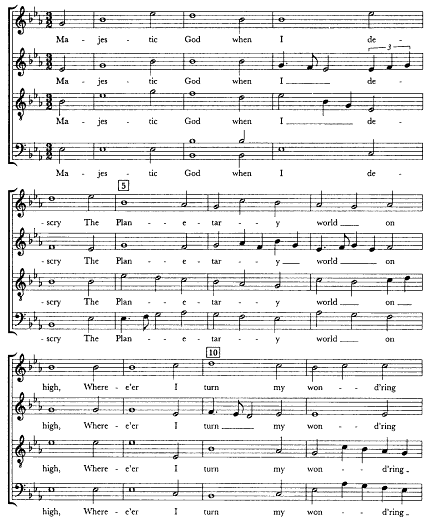
Example. 2.
William Billings, SUNDAY (Billings) (The Singing Master's Assistant [1778]; after
Hans Nathan, ed., The Complete Works of William Billings, vol. 2 [Charlottesville,
VA., 1977], 178)
(continued )
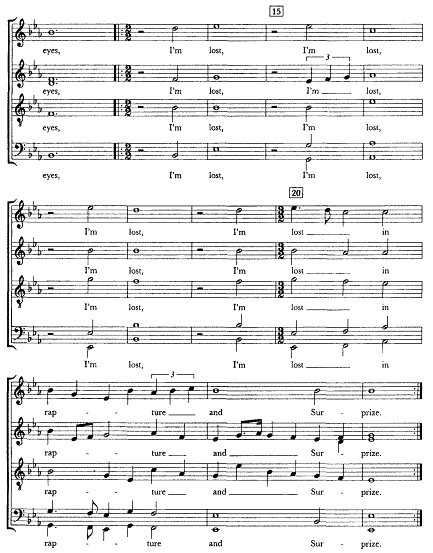
Example. 2.
(continued)
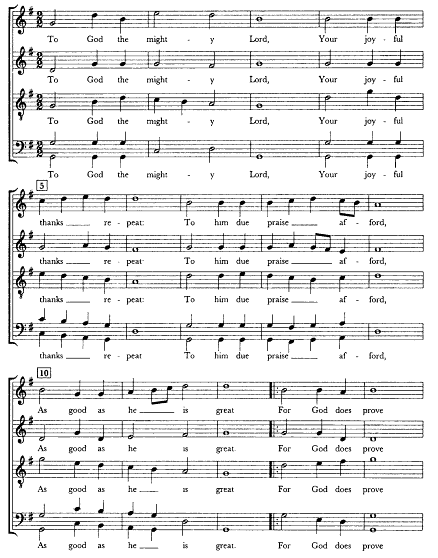
Example 3.
Billings, AMHERST (Brady and Tate) (Singing Master's Assistant [1778]
after Nathan, ed., Complete Works of William Billings, vol. 2, 54)
(continued )
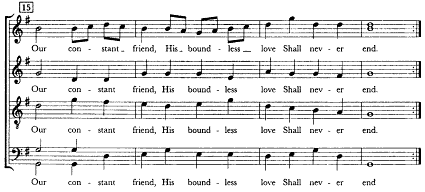
Example 3
(continued)
their own day. Second, we need to trace the paths of these pieces through the printed anthologies, compiling a printing history of each. And third, we need to look at anthologies themselves—to think of each anthology as a whole and then try to see how the compositions it contains make it a whole, or at least made it seem a whole to its compiler. By looking at individual pieces, their circulation, and the tunebooks—the "wholes" compilers created from the pieces they had to choose from— perhaps we can increase our knowledge of why compilers made the choices they did.
Early American psalmody as printed music begins in 1698, when the first sacred music in English was published in Boston, and continues to 1810, by which time American-born New England composers were beginning to be displaced by "improved" tunes with a more European stamp. During that 112-year period, 545 different issues of sacred music were printed, and they contained a total of some 7,500 compositions. Obviously, the present account can only scratch the surface of that vast repertory's dissemination. So, to narrow the focus and provide a window on the subject, I've decided to choose a single tunebook—a successful one, whose compositions circulated widely—and see what we can learn by tracing the dissemination of the music it contained. My candidate is The Singing Master's Assistant (Boston, 1778), Billings's greatest success.
In 1770, Billings had brought out his first tunebook, The New-England Psalm-Singer , which contained 127 of his own compositions. The thrill of that achievement lingered in his memory for years.
Kind Reader, no doubt you (do, or ought to) remember, that about eight years ago, I published a Book entitled, The New-England Psalm-Singer , &c. And truely a most masterly and inimitable Performance, I then thought it to be. Oh! how did my foolish heart throb & beat with tumultuous joy! With what impatience did I wait on the Book-Binder, while stitching the sheets and puting on the covers, with what extacy, did I snatch the yet unfinished Book out of his hands, and pressing it to my bosom, with rapturous delight, how lavish was I, in encomiums on this infant production of my own Numb-Skull?
But as Billings grew in musical experience, his pride in The New-England Psalm-Singer waned. By 1778, when he approached the public with his second work, he felt obliged to apologize for his first and to promise improvement:
After impartial examination, I have discovered that many of the pieces in that Book were never worth my printing, or your inspection; therefore in order to make you ample amends for my former intrusion, I have selected and corrected some of the Tunes which were most approved of in that book, and have added several new pieces which I think to be very good ones; for if I thought otherwise, I should not have presented them to you. But however, I am not so tenacious of my own opinion, as to desire you to take my word for it; but rather advise you all to purchase a Book and satisfy yourselves in that particular, and then, I make no doubt, but you will readily concur with me in this sentiment, viz. that the Singing-Master's Assistant is a much better Book, than the New-England Psalm-Singer .[16]
The public agreed with Billings's judgment of his new collection. Before the end of the next decade, The Singing Master's Assistant had appeared in four editions, all with the same music. Moreover, although he had fought to prevent it, his fellow compilers had given his new book the ultimate form of praise by raiding it heavily: Of the seventy-one pieces in the work, fifty-one, or nearly three-quarters, were reprinted in other tunebooks—by far the highest proportion of any collection of Billings's music.
The first step in considering how the music in Billings's tunebook circulated is to look at more of its pieces. As noted with AMHERST and
SUNDAY , The Singing Master's Assistant is made up entirely of unaccompanied choral music set in open score for four voices, called treble, counter, tenor, and bass, with the melody in the tenor voice. The basic musical form is the so-called plain tune, in which a stanza of metrical text is set to music without word repetition. Thus, in the plain tune, the form of the text is entirely responsible for determining the form of the music. AMHERST is a plain tune; so is BROOKFIELD (ex. 4); and so is CHESTER (ex. 5). In some pieces, Billings breaks the mold of the metrical form by repeating text, usually for expressive purposes. SUNDAY is one and MAJVSTY (ex. 6) another. Moreover, MAJESTY sets two stanzas of text, introducing texture changes to striking effect. Elsewhere, I've proposed calling such pieces "tunes with extension."[17] MAJESTY , by the way, is a piece that Harriet Beecher Stowe remembered being sung in the meeting house when she was growing up in Litchfield, Connecticut.
Whatever the trained musician might say of such a tune as old Majesty, no person of imagination or sensibility could hear it well rendered by a large choir without deep emotion. And [at the words]
On cherubim and seraphim
Full royally He rode,
And on the wings of mighty winds
Came flying all abroad,
There went a stir and thrill through many a stern and hard nature.[18]
Psalmodists in the Anglo-American tradition formalized such elaborations in so-called fuging tunes, which contained at least one section with successive vocal entries producing text overlap. Sometimes the fuging section followed an opening section in block chords, as in MARYLAND (ex. 7). Often the fuging voices entered with some kind of imitation; MARYLAND is one of many New England fuging tunes in which the imitation is rhythmic but not melodic.
The forms described so far are strophic, with later stanzas sung to the same music as the first. Psalmodists also wrote through-composed pieces; most often these were settings of prose based on scripture. The Singing Master's Assistant included ten anthems, none of them reproduced here.
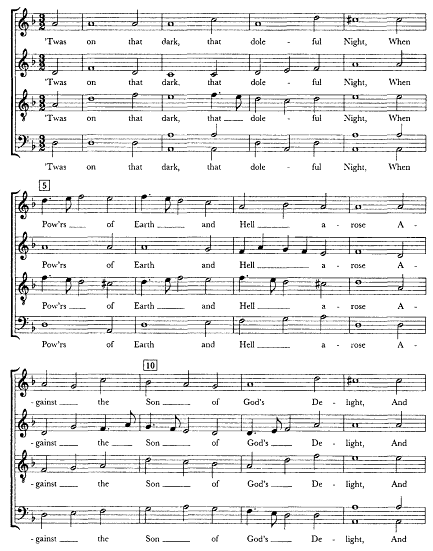
Example. 4.
Billings, BROOKFIELD (Watts) (Singing Master's Assistant [1778];
after Nathan, ed., Complete Works of William Billings, vol. 2, 48)
(continued )
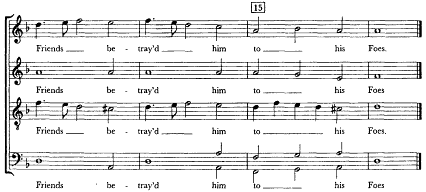
Example 4
(continued)
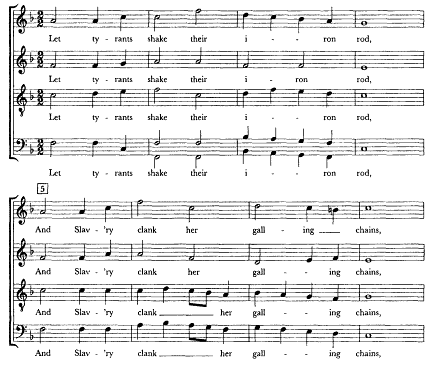
Example 5.
Billings, CHESTER (Billings) (Singing Master's Assistant [1778];
after Nathan, ed., Complete Works of William Billings, vol. 2, 72)
(continued )
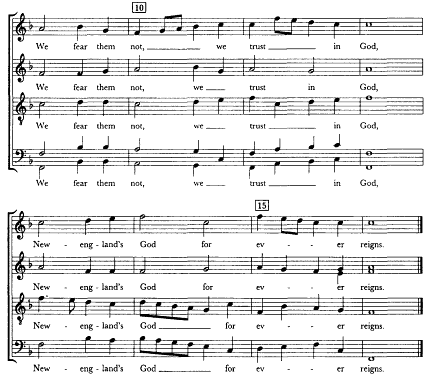
Example 5
(continued)
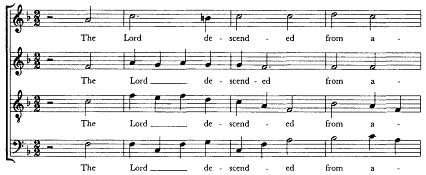
Example 6.
Billings, MAJESTY (Sternhold and Hopkins) (Singing Master's
Assistant [1778]; after Nathan, ed., Complete Works of William
Billings, vol. 2, 203)
(continued )
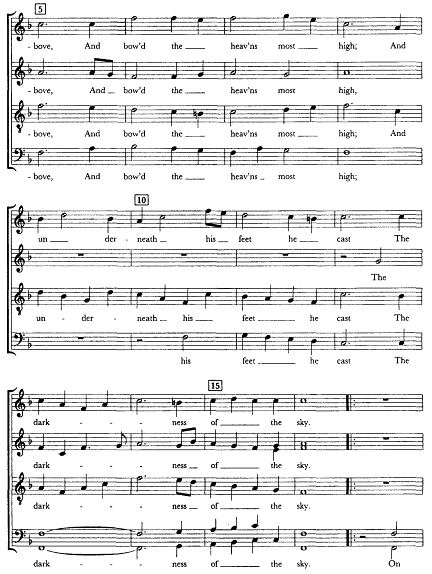
Example 6
(continued)
(continued )
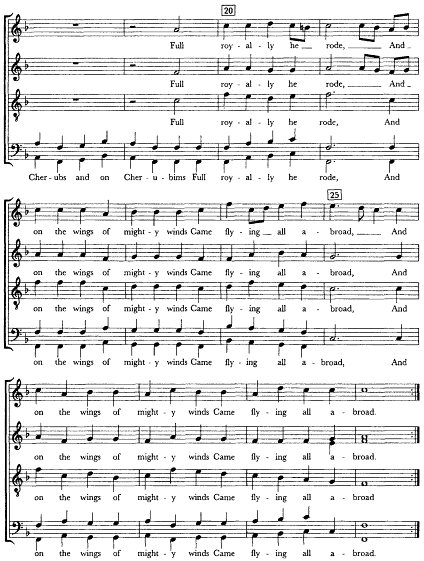
Example 6
(continued)
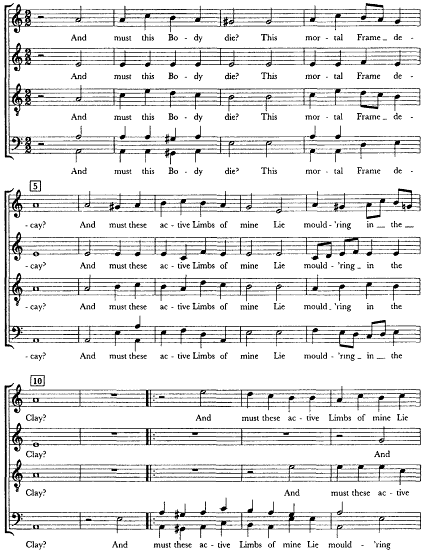
Example 7.
Billings, MARYLAND (Watts) (Singing Master's Assistant [1778];
after Nathan, ed., Complete Works of William Billings, vol. 2, 126)
(continued )
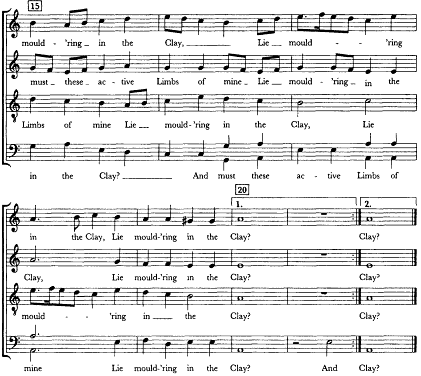
Example 7
(continued)
The structures of text and musical form available to Billings provide one approach to the music in his book. There's another property of the music, however, that cuts closer to the heart of how it was most likely experienced by those who sang it. It should be remembered that, although Billings composed some pieces requiring the skill of a well-rehearsed choir, he and his brother psalmodists wrote most of all for Christians of modest vocal experience. Functionally, their compositions were extensions of congregational singing, where, as Alan Lomax once wrote, a "society" of people "call out to God together across the infinite."[19] The music, in other words, has its life in a broad context of ritual, where the singers join in declaiming sacred text, their words and voices reinforcing belief in their own hearts, but with the expectation that their singing is also being perceived by God, to whom it is ultimately addressed.
Psalmody, then, is communal sacred declamation governed by music. Because the experience of psalmody depends upon the way in which text is declaimed—on the way words flow through time, carried by the rise and fall of the vocal lines—when we consider the musical properties of pieces, declamation must be a primary concern. LEBANON (ex. 8) shows the oldest style of declamation in Anglo-American psalmody: the so-called common-tune style, whose notes of equal value move in slow-paced duple time.[20] The common-tune style harks back to Reformation times and to tunes like OLD HUNDRED , the so-called "Doxology." LEB-ANON also illustrates some of what Billings learned between his first book and his second. Example 8 is from The New-England Psalm-Singer , where the original barring, shown above the staff, ignores the placement of stressed syllables. Example 9 shows that by the time of The Singing Master's Assistant Billings understood that musical and metrical accents must be coordinated, and he reshaped the tune's beginning through a dactyl in the first measure.
The declamation that best fits the prevalent verse patterns of English psalmody and hymnody is iambic, alternating short notes and long, and supporting weak and strong verbal accents, as in BROOKFIELD (ex. 4). Iambic movement is usually cast in triple time. Like BROOKFIELD , many iambic tunes achieve their sense of melodic motion by dissolving whole notes into halves, or perhaps dotted quarters and eighths. The beginnings of later stanzas of BROOKFIELD fit more comfortably with Billings's music than does the underlaid one, whose first two words have their natural accent switched. A better solution for those opening words of BROOKFIELD would be a dactylic beginning: long-short-short. And indeed The Singing Master's Assistant has many tunes whose declamation is based on the dactyl in duple time. AMHERST (ex. 3) is a good example. Each of its six phrases begin dactylically; and all four phrases of CHESTER (ex. 5) do the same.
The style of declamation that has come to be thought of as most characteristically American in this repertory is found in MAJESTY (ex. 6). Here we have a duple-time piece in two sections, the first moving chiefly in half notes, the second shifting to syllabic declamation in quarters. MAJESTY is not a fuging tune. But in its two-part form and the aggressive text delivery of its second section, it follows the declamatory practice of many fuging tunes. Elsewhere, I've called the latter kind of motion "declamatory duple,"[21] its essence being that while the unit of
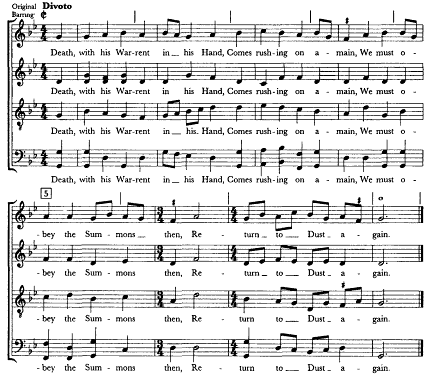
Example 8.
Billings, LEBANON OR FUNERAL HYMN (Billings) (The New-England
Psalm-Singer [1770]; after Karl Kroeger, ed., The Complete Works of
William Billings, vol. 1 [Charlottesville, Va., 1981], 333)
motion is the half note, one or more sections of the piece deliver text syllabically in quarter notes, producing a strong forward thrust. MARY-LAND (ex. 7) is also a declamatory duple tune.
BETHLEHEM (ex. 10) shows another declamatory approach that Billings liked. It begins in triple time, setting a full stanza of text as if it were an iambic plain tune. But then meter and texture unexpectedly change, the gentle swing of the opening giving way to the march of a duple-time fuging section as lines three and four of the text are repeated.
The styles of declamation shown here are fundamental expressive resources of the tradition of psalmody in which Billings worked. Once
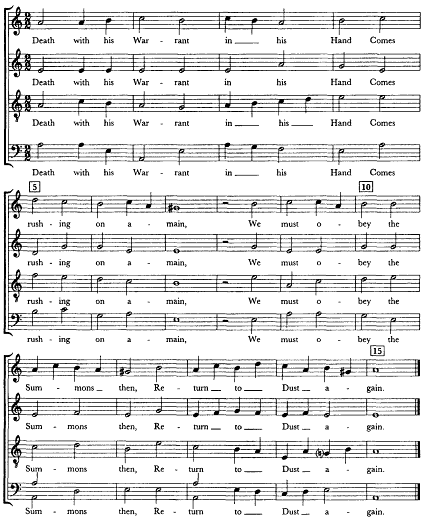
Example 9.
Billings, LEBANON (Billings) (Singing Master's Assistant [1778];
after Nathan, ed., Complete Works of William Billings, vol. 2, 78)
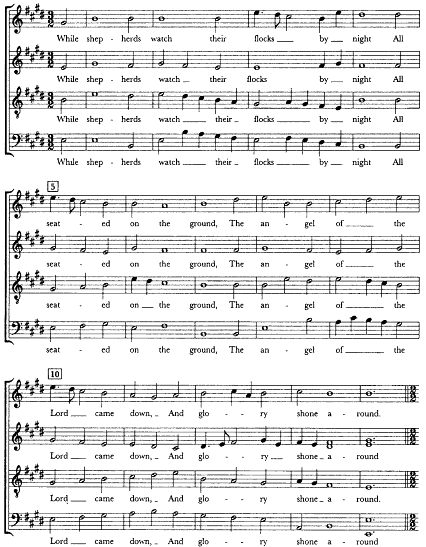
Example 10.
Billings, BETHLEHEM (Watts) (Singing Master's Assistant [1778];
after Nathan, ed., Complete Works of William Billings, vol. 2, 207)
(continued )
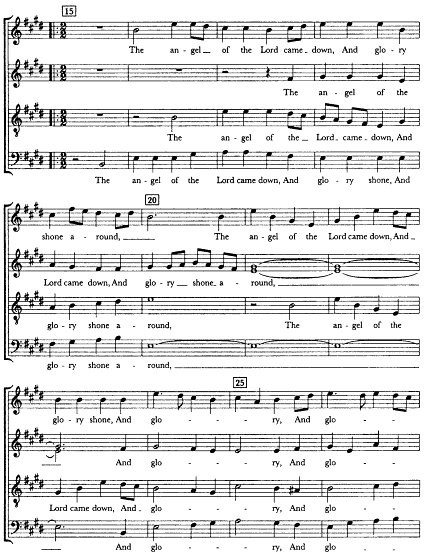
Example 10
(continued)
(continued )
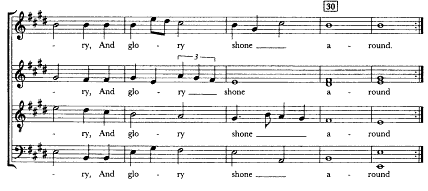
Example 10
(continued)
begun, especially in a piece of strophic music that went on for many stanzas, each one established its own way of moving, which is why the breaking of the pattern, as in BETHLEHEM , or in SUNDAY , produces a sharp sense of contrast, hence of event. Billings was fond of such contrasts.
To summarize, we can say that in Billings's The Singing Master's Assistant both strophic settings of verse and through-composed settings of prose are found; the musical forms include plain tunes, tunes with extension, fuging tunes, and anthems; and in the settings of verse, styles of text declamation vary from the common-tune style to iambic, dactylic, declamatory duple, and mixtures thereof. These are some, though by no means all, of the traits that distinguish compositional types in early American psalmody.
Now let's find out what happened to the music in The Singing Master's Assistant after Billings published it. As a beginning, here's a list of the nine pieces used as examples in this chapter, with the number of printings each received in American tunebooks between 1778 and 1810.[22]
AMHERST | 74 | CHESTER | 56 | LEBANON | 48 |
SUNDAY | 4 | MAJESTY | 75 | BETHLEHEM | 42 |
BROOKFIELD | 88 | MARYLAND | 60 | JUDEA | 4 |
Next, there's the question of where the tunes appeared in print. The geographical extent of circulation for printed sacred compositions of Billings's time may be shown by noting some of the printings outside Boston of BROOKFIELD , the tune by Billings most widely published in his own day. In 1779, BROOKFIELD appeared in a Connecticut tune-book. In the 1780s, it was picked up in northern and central Massachusetts (Newburyport, Worcester), in Philadelphia in 1788, and New York City in 1789. The next decade saw printings in Baltimore (1793), upstate New York and New Hampshire (1795), and dissemination as far south as Charleston, South Carolina (1799); by 1810 it had appeared as far west as Harrisburg, Pennsylvania.[23] A colonial New England hymn tune had won acceptance as a national favorite in the United States of the Federal era.
It was suggested earlier that tracing the circulation of each piece in Billings's tunebook would be a logical second step in our study of musical dissemination. And indeed, this work has been done. But the best way to convey its results—to do justice to both the larger question on the table and to the horde of bibliographical details on which an answer is based—is to move on to the third step: to look at the anthologies in which the tunes appear, to get a sense of their character and makeup, and then to return to the issue of dissemination with those notions in mind.
What kind of a book was The Singing Master's Assistant itself? First, Billings's work was intended chiefly for singing schools, as suggested by its title and shown by its front matter, which includes extensive rudiments for learners and ample advice for teachers. In addition, as table 1 shows, it was a work whose text sources ranged widely—from books like Brady and Tate's A New Version and Watts's The Psalms of David Imitated and Hymns and Spiritual Songs ,[24] sources for several generations of English and American composers, to local poets such as Samuel Byles, Perez Morton, and even Billings himself. Furthermore, the texts Billings set in The Singing Master's Assistant covered a wide range of metrical patterns, from the familiar trio of common, long, and short meter to arrangements rarely encountered in psalmody of the period. Billings's book also contained ten anthems, which fill nearly half its pages. Table 1 shows that the book's settings of verse were balanced among declamatory styles. Finally, to a degree unmatched by any other American tunebook of its time, The Singing Master's Assistant is a personal and
TABLE 1 | |
A. METERS | |
Metrical structure | No. compositions |
CM (8.6.8.6) | 20 |
LM (8.8.8.8) | 14 |
SM (6.6.8.6) | 8 |
HM (6.6.6.6.4.4.4.4) | 5 |
PM, Ps. 50 (four 10s, two 11s) | 2 |
PM, Ps. 149 (10.10.11.11) | 2 |
PM, Ps. 122 (6.6.8.6.6.8) | 2 |
PM (six 8s) | 2 |
PM (six 11s) | 1 |
PM (8.7.8.7.7.8) | 1 |
PM (8.7.8.7) | 1 |
PM (5.6.5.6.6.6.4) | 1 |
PM (four 7s) | 1 |
PM (11.11.11.5) | 1 |
B. SETTINGS OF VERSE AND PROSE | |
61 settings of verse | |
10 settings of prose | |
C. TEXT DECLAMATION OF VERSE SETTINGS | |
Style of declamation | No. compositions |
common-tune style | 5 |
dactylic | 11 |
iambic | 17 |
declamatory duple | 13 |
mixture | 10 |
spondaic | 4 |
other | 1 |
(continued ) | |
(table continued on next page)
TABLE 1 (continued ) | |
D. SOURCES OF TEXTS | |
Author, title | No. texts |
John Arnold, The Compleat Psalmodist , 4th ed. (London, 1756) | 1 |
Arthur Bedford, The Excellency of Divine Musick (London, [1733])a | 1 |
King James Bible | 9 |
William Billingsb | 11 |
Nicholas Brady and Nahum Tate, A New Version of the Psalms of David (London, 1696) | 11 |
Nicholas Brady and Nahum Tate, A New Version of the Psalms of David (Boston, 1773), Appendix, Containing a Number of Hymns, Taken Chiefly from Dr. Watts s Scriptural Collection | 1 |
Brady and Tate, New Version , and Watts, Psalmsc | 1 |
[Samuel Byles,] Pious Remains of a Young Gentleman Lately Deceased (Boston, 1764) | 1 |
Thomas Flatman, Poems and Songs (London, 1674) | 1 |
Perez Mortond | 1 |
James Relly and John Relly, Christian Hymns, Poems, and Spiritual Songs (Burlington, N.J., 1776) | 1 |
Thomas Sternhold and John Hopkins, The Whole Book of Psalms (London, 1562) | 1 |
Isaac Watts, Divine and Moral Songs for the Use of Children (London, 1715) | 1 |
Isaac Watts, Horae Lyricae (London, 1706) | 1 |
Isaac Watts, Hymns and Spiritual Songs, in Three Books (London, 1707-9) | 14 |
Isaac Watts, The Psalms of David Imitated in the Language of the New Testament (London, 1719) | 11 |
George Whitefield, A Collection of Hymns for Social Worship , 13th ed. (Philadelphia, 1768) | 4 |
E. DISSEMINATION | |
51 of 71 pieces reprinted in other books | |
a See Appendix entitled "A Specimen of Hymns for Divine Musick." | |
b On p. [3] of The Singing Master's Assistant (1778), Billings writes: "I have been very careful to give credit for words, and where no credit is given, the words were written by the author." That statement allows the texts to AMERICA , AURORA , BALTIMORE , BOSTON , CHESTER , COLUMBIA , INDEPENDENCE , JARGON , LEBANON NEW HINGHAM , and SUNDAY to be identified as Billings's own. | |
c The text of STOCKBRIDCE is a composite. See Billings, Complete Works , 2:350. | |
d "When Jesus Wept," the text for EMMAUS , is traced to Morton in Billings, Complete Works , 2:347. | |
patriotic statement: the work of an American composer bursting with opinions, bedazzled with music as sense experience, and spiritually if not physically engaged in his country's present struggle for political independence.[25]
The Singing Master's Assistant reflects something else about the makeup of other eighteenth-century American tunebooks. In the twentieth century these anthologies, when noticed at all, are usually viewed as preservers of music. But to pass muster in the eighteenth-century marketplace, a tunebook also had to take other factors into account. Many tunebooks, though not all, sought to embrace the whole tradition of psalmody within one set of covers. They were designed to be the one book that would do it all, meeting the needs of beginners and experienced singers (not to mention those in between), of congregations, schools, choirs, and singing societies, by including everything from simple congregational pieces in common-tune style to anthems for choir performance on special occasions. Tunebooks of the eighteenth century also had to take certain theological guidelines into account. They had to include music in enough different text meters to cover all the psalms and hymns in the hymnals, and they had to contain sacred texts suitable for singing in both worship and recreation. The better a tunebook balanced artistic, pedagogical, and religious elements, the better its chance for success in the marketplace.[26]
A further word on texts. Not only was a tunebook expected to accommodate all the meters of the text in the hymnbook. Its music also had to suit the range of moods that the hymnbook expressed: minor-mode or "flat-key" tunes for sorrowful texts and major-mode tunes for triumphant ones. Thus, a tunebook needed a variety of both major- and minor-mode tunes in each of the most widely used meters; and it also needed at least one piece for each of the more unusual meters. It must be emphasized that in New England psalmody of the time, many tune-text linkings were not marriages but common-law liaisons, and printed pieces should not necessarily be considered musical-textual entities. Different texts of the same meter could be and were substituted by singers for the printed ones, according to personal choice, as with CHESTER .[27] Theologically speaking, a tune might be considered as little more than a convenient melodic formula to which any text in its meter could be sung. For example, between 1698 and 1810, the long meter tune OLD
HUNDRED was printed in America with sixteen different texts in the standard psalters and hymn books.[28]
When we think of the needs that the early American tunebook was designed to fill, and the music that was available to meet them, we can begin to get a clearer picture of how compilers made their choices. Perhaps, with all this talk of functions, texts, moods, poetic meters, styles of declamation, and religious denominations, we ought to think of the tunebook itself as a particular kind of structure—not so much a transcript of the compiler's taste (though taste surely played into it) but a formal grid divided, like an old-fashioned typesetter's case, into pigeon holes. Each pigeon hole might be considered a category of tune. And just as the typesetter needed certain numbers of each letter (more e 's and s 's than q 's and x 's), the compiler needed certain numbers of each category of tune to fill the pigeon holes of the structure he was building. Or, to try another simile, a compiler chose tunes in something of the way a baseball team selects new players. The team chooses not just the best athletes but those who are most promising at the positions it needs to fill: shortstop, catcher, or left-handed pitcher. Likewise, the tunebook compiler filled his pigeon holes according to categories of text and music. Tunes in the same category were weighed against each other: this minor-mode fuging tune in long meter or that one? This funeral anthem or that? This setting of "While shepherds watch'd their flocks by night" or that? Harking back to the earlier comparison of AMHERST and SUNDAY on the basis of my personal notion of their aesthetic appeal, we now see that it was irrelevant. AMHERST owed its circulation chiefly to its metrical structure: It is cast in the pattern 6.6.6.6.4.4.4.4, the so-called hallelujah meter, in which Psalms 136 and 148 were versified. Its competition was not SUNDAY, a long meter tune, nor any tune in common meter, long meter, short meter, or meters other than its own. AMHERST was chosen by many compilers because it best filled the hallelujah meter pigeon hole, which, if left unfilled, would leave the tune-book incomplete. A tunebook had to have at least one hallelujah meter tune or users who wished to sing the entire psalter would have to look elsewhere.[29]
Another question needs to be asked: What music was available to a compiler when he made his choices? The issue is partly one of historical chronology and partly one of law.
If William Billings had had his way, he would have controlled the circulation of his music himself. In fact, Billings was the first American composer to seek copyright protection for his compositions. In 1770 and again in 1772, he petitioned the Massachusetts legislature for exclusive right to reprint his own music; and in 1778, as The Singing Master's Assistant was about to appear, he sought copyright protection again. Neither petition was granted.[30] Hence, other compilers had the right to raid Billings's books freely and to reprint any of the music in them. And they did. In 1783, the Massachusetts legislature finally ruled to "secur[e] to Authors the exclusive Right and Benefit of publishing their Literary Production, for Twenty-one Years," backing up their action with fines.[31] Indeed, Billings's next work, The Suffolk Harmony (1786), was copyrighted and deposited in the Harvard College Library, as the law specified. But because the copyright law applied only within the State of Massachusetts, out-of-state compilers could still help themselves. Not until 1790, when the federal copyright law was passed, was there legal restraint throughout the country upon musical piracy. It was no coincidence that the circulation of pieces from The Continental Harmony (1794), the only one of Billings's tunebooks published after the enactment of the federal law, was by far the smallest of any of his tune-books.[32]
It should now be obvious that the field in which a compiler made his choices was one structured by its own prescriptions and boundaries and that compiling an anthology required more than simply assembling a collection of favorite pieces. Another factor seems to have influenced compilers in the years immediately following the publication of The Singing Master's Assistant . Billings's tunebook appeared in a fallow period for the American tunebook trade as a whole. Wartime conditions reduced publication opportunities, and, during the entire decade of the 1770s, only twelve issues of sacred music were published, while in the 1780s more than four times that many appeared in print.[33]The Singing Master's Assistant , in other words, was published just before the American tunebook trade burst into full bloom. Unprotected by copyright, and full of fresh, attractive music, it was there to be raided by any other compiler.
These words about The Singing Master's Assistant and tunebooks in general provide a context for examining some of the collections in which music from Billings's book appeared in the decade after it was published (1779-89). All the works listed in table 2 were compiled with factors we
have mentioned in mind. But the collection at the top of the list introduced another card into the deck: the issue of national origin. Andrew Law's Select Harmony (1779) was the first American tunebook to include English and American music in roughly equal proportion. Except for Billings's two collections, which contained only his own pieces, earlier tunebooks had been devoted either entirely or almost entirely to English music. But Law mixed an assortment of English tunes and anthems with pieces by New England composers—Oliver Brownson, Amos Bull, Abraham Wood, and others—among whom only Billings, from whom he borrowed six tunes, had been published before. Law's eclectic model and his inclusion of native-born composers were to have a powerful impact through the next decade.
Simeon Jocelin followed Law's approach to compiling in The Chorister's Companion (1782-83). Like Law, Jocelin balanced English and American pieces and introduced works by several new American composers, including Lewis Edson and Daniel Read. He also borrowed nineteen pieces from Billings's The Singing Master's Assistant . In 1783, Oliver Brownson of Simsbury brought out a tunebook emphasizing his own music and that of other Americans, though it did include a few English pieces. John Stickney's work of 1783 was the second edition of a prewar tunebook whose contents were chiefly English. Its publisher, Daniel Bayley of Newburyport, Massachusetts, was by far the most active prewar American compiler, most of his tunebooks being reissues of collections by English psalmodists. By 1784 Bayley was doing his borrowing closer to home—from Connecticut, in fact. His Select Harmony took the title and much of the contents of Law's earlier work, even listing Law's name on the title page. (Given the copyright situation, there was nothing illegal in this.) And Bayley's publications of 1785 and 1788 also intermixed British and American pieces. Chauncey Langdon's 1786 collection, the work of a student member of the Yale College singing society, emphasized American compositions. Law's 1786 work continued his earlier eclectic policy. All of this activity set the stage for The Worcester Collection of Sacred Harmony .
The Worcester Collection was the first American tunebook of the period compiled by a nonmusician: Isaiah Thomas of Worcester, Massachusetts, a professional printer who described himself as "unskilled in musick." Thomas's anthology followed the now-familiar eclectic model with its mixture of English and American pieces and its emphasis on compo-
TABLE 2 | ||
Year | Author, title, place | Provenance |
1779 | Andrew Law, Select Harmony (Farmington | 26 American |
[i.e., Cheshire], Conn.) | 39 non-American | |
1782 | Andrew Law, Select Harmony [2d ed.] | 21 American |
([Cheshire, Conn.]) | 38 non-American | |
1782-83 | [Simeon Jocelin,] The Chorister's Companion | 50 American |
(New Haven, 1782), with The Chorister's | 61 non-American | |
Companion, Part Third (New Haven, | 5 unidentified | |
1783 | Oliver Brownson, Select Harmony ([Simsbury, | 52 American |
Conn.]) | 17 non-American | |
2 unidentified | ||
John Stickney, The Gentleman and Lady's | 15 American | |
Musical Companion [2d ed.] (Newburyport) | 99 non-American | |
2 unidentified | ||
1784 | [Daniel Bayley,] Select Harmony, Con- | 32 American |
taining . . . the Rules of Singing Chiefly by | 111 non-American | |
Andrew Law, A.B . (Newburyport) | 3 unidentified | |
The Massachusetts Harmony (Boston) | 17 American | |
67 non-American | ||
7 unidentified | ||
A New Collection of Psalm Tunes Adapted to | 6 American | |
Congregational Worship ([Boston]) | 44 non-American | |
1 unidentified | ||
1785 | Daniel Bayley, The Essex Harmony, or Musical | 13 American |
Miscellany (Newburyport) | 27 non-American | |
1 unidentified | ||
1786 | [Chauncey Langdon,] Beauties of | 23 American |
Psalmody . . . by a Member of the Musical | 2 non-American | |
Society of Yale College ([New Haven]) | 2 unidentified | |
Andrew Law, The Rudiments of Music , 2d ed. | 23 American | |
([Cheshire, Conn.]) | 17 non-American | |
2 unidentified | ||
The Worcester Collection of Sacred Harmony | 73 American | |
(Worcester) | 33 non-American | |
2 unidentified | ||
(continued) | ||
(table continued on next page)
TABLE 2 | ||
Year | Author, title, place | Provenance |
1787 | Daniel Read, The American Singing Book , | 68 American |
with Supplement to the American Singing Book (New Haven) | 6 non-American | |
1788 | Daniel Bayley, Sr., The New Harmony of Zion | 38 American |
(Newburyport) | 47 non-American | |
2 unidentified | ||
The Federal Harmony (Boston) | 94 American | |
32 non-American | ||
3 unidentified | ||
[Simeon Jocelin,] The Chorister's Companion , | 41 American | |
2d ed. (New Haven) | 68 non-American | |
1 unidentified | ||
Sacred Harmony or A Collection of Psalm | 79 American | |
Tunes, Ancient and Modern (Boston) | 49 non-American | |
4 unidentified | ||
A Selection of Sacred Harmony (Philadelphia) | 26 American | |
32 non-American | ||
4 unidentified | ||
The Worcester Collection of Sacred Harmony , | 82 American | |
2d ed. (Worcester) | 34 non-American | |
2 unidentified | ||
1789 | [Andrew] Adgate and [Ishmail] Spicer, | 30 American |
Philadelphia Harmony (Philadelphia) | 30 non-American | |
1 unidentified | ||
sitions that, by appearing in other tunebooks, had proved or were proving themselves to be favorites. Unlike its predecessors, all printed on a rolling press from engraved plates, The Worcester Collection was printed by letterpress, making possible larger press runs and a lower price per page.[34] Linking this new technology with an effective system of book distribution and a compiling strategy aimed toward the center of the market, The Worcester Collection crystallized the type of anthology that Law and Jocelin had introduced and Bayley had borrowed. Its example was widely copied, and its repertory gained especially wide circulation.[35] Thus, the music it printed received a special boost toward broad acceptance. (Nineteen of the seventy-three American compositions printed in the first edition of The Worcester Collection were by William Billings.)
The rest of the books in table 2 show the influence of The Worcester Collection , either directly or indirectly, and carry a selection of music chosen with its emphases in mind. In fact, they include many of the same pieces. Read's Supplement (1787), an appendix to his The American Singing Book (1785), which had contained only his own compositions, was chosen almost entirely from among familiar English and American favorites. Several 1788 tunebooks show other professional printers being drawn into the sacred music trade, following Thomas's example. The Federal Harmony , published by the Boston engraver John Norman, insisted on the superiority of its own copperplate engraving to the letterpress method; Sacred Harmony , compiled anonymously, mentioned The Worcester Collection on its title page; the Selection of Sacred Harmony , the first major Philadelphia tunebook since the 1760s, came from the press of newspaper publisher John M'Culloch; and Adgate and Spicer's Philadelphia Harmony contained a higher proportion than any work yet of that group of favorites that has been identified as the "core repertory" of early American psalmody—the 101 sacred compositions most frequently printed in America before the end of 1810.[36]
Thus, in the late 1770s and 1780s, many American compositions were printed in American anthologies, and the process of winnowing took place, accelerating after 1786. Billings's music, especially the music from his The Singing Master's Assistant , was fight in the center of this development.
The key work in the dissemination of Billings's compositions was Jocelin's The Chorister's Companion (1782-83; see table 3).[37] Jocelin borrowed heavily from Billings. He picked up no fewer than nineteen pieces from The Singing Master's Assistant (see table 3C), and he added six more from Billings's next major tunebook, The Psalm-Singer's Amusement (1781), for a total of twenty-five Billings pieces in all. But these numbers only begin to tell the story of Jocelin's borrowing. Of the twenty-five compositions by Billings that were printed fifteen times or more in any American tunebook before 1811 (table 3A), nearly two-thirds (sixteen of the twenty-five) appeared in Jocelin (table 3B). Moreover, Jocelin was the first compiler after Billings to print eleven of those sixteen compositions, suggesting that if he had not picked them up, other compilers might not have either. More than any other tunebook, then, Billings's own The Singing Master's Assistant included, Jocelin's The Chorister's
TABLE 3 | |||
A. Pre-1782 Billings pieces with 15 printings or more | |||
AFRICA | BOSTON | MENDOM | |
AMERICA | BROOKFIELD | NEW HINGHAM | |
AMHERST | CHESTER | PARIS | |
Anthem: I Am the Rose of Sharon | COLUMBIA | PHILADELPHIA | |
EMMAUS | RICHMOND | ||
Anthem: I Heard a Great Voice | GOLGOTHA | STOCKBRIDGE | |
AURORA | LEBANON | SUFFOLK | |
BERLIN | MAJESTY | WASHINGTON | |
BETHLEHEM | MARYLAND | (25 pieces ) | |
B. Pre-1782 Billings pieces with 15 printings or more in Jocelin | |||
AMERICA | BROOKFIELD | PARIS | |
AMHERST | CHESTER | PHILADELPHIA | |
AURORA | COLUMBIA | STOCKBRIDGE | |
BERLIN | MARYLAND | WASHINGTON | |
BETHLEHEM | MENDOM | (16 pieces ) | |
BOSTON | NEW HINGHAM | ||
C. Music from SMA in Jocelin | |||
AMERICA | COLUMBIA | PRINCETON | |
AMHERST | HEBRON | SHERBURNE | |
AURORA | MARYLAND | STOCKBRIDGE | |
BETHLEHEM | NEW HINGHAM | WARREN | |
BOSTON | NEW NORTH | WASHINGTON | |
BROOKFIELD | NEW SOUTH | (19 pieces ) | |
CHESTER | PHILADELPHIA | ||
D. Declamatory styles and meters of SMA tunes in Jocelin | |||
common-tune | NEW NORTH (CM) | ||
iambic | AMERICA (six 8s), BROOKFIELD (LM), HEBRON (SM), NEW SOUTH (SM), PRINCETON (CM), WARREN (four 7s) | ||
(continued ) | |||
(table continued on next page)
TABLE 3 | ||
dactylic | AMHERST (HM), CHESTER (LM), COLUMBIA (HM) | |
declamatory duple | BOSTON (CM), MARYLAND (SM), NEW HINGHAM (SM), SHERBURNE (6.6.8.6.6.8), STOCKBRIDGE (LM), WASHINGTON (LM) | |
mixed | AURORA (SM), BETHLEHEM (CM), PHILADELPHIA (SM) | |
E. Pieces from SMA in Worcester Collection (1786) | ||
AMERICA | CHESTER | PHILADELPHIA |
AMHERST | COLUMBIA | STOCKBRIDGE |
AURORA | HEBRON | WASHINGTON |
BETHLEHEM | MARYLAND | (13 pieces; cf. C above ) |
BROOKFIELD | NEW HINGHAM | |
Companion seems to have played a decisive role in determining which of Billings's pieces lived on and which were forgotten.
What, if anything, can be discovered about the reasons for Jocelin's influence upon the fate of Billings's music? The compositions he borrowed suggest some answers.
Jocelin took from Billings a group of pieces that, examined from the standpoint of meters and styles of declamation, forms a remarkably well-balanced cross-section of Anglo-American psalmody in general and of Billings's own work in particular. Among the nineteen compositions he chose from The Singing Master's Assistant (table 3C and D), Jocelin took only one common tune, preferring to fill that category in his own book with European favorites. But for the other categories of declamation he chose six iambic tunes, three dactylic, six declamatory duple tunes, and three mixed ones. Within these categories, he paid close attention to the variety of poetic meters. His six iambic tunes, for example, use five different text meters; further, half of them are in the major mode and half in the minor. The variety of text meters in the Billings tunes is similarly wide. With seven different meters distributed among the nineteen compositions, here was a selection of Billings pieces covering all but one meter in the entire hymnbook. Jocelin's borrowings
from The Singing Master's Assistant , in short, are by no means random, nor is it likely that simple personal preference would have produced so varied a sample. The borrowings show every sign of being systematic. They constitute in effect a tunebook within a tunebook: a microcosm of the work of Billings as a composer of metrical sacred music. Jocelin's raid may have worked against the composer's commercial interests, but it revealed a shrewd understanding of the legacy that Billings had created for his public in The Singing Master's Assistant .
Having noted and looked at some of the pieces Jocelin took from Billings, perhaps it's worth mentioning one he rejected. The Christmas hymn JUDEA has had a certain currency since it was edited and published in the 1940s in an octavo edition and recorded by the Robert Shaw Chorale (1952). JUDEA , however, went nowhere in Billings's own time, dropping out of print after The Singing Master's Assistant itself. The tune is one of a handful of spondaic pieces in the book; none of these were much reprinted.[38] Its text meter, six 11s, is nowhere to be found in the standard hymnbooks. And its character is decidedly that of a dance.[39] There is reason to think that Jocelin had JUDEA (ex. 11) in mind when, in his introduction, after praising the new style of psalm tune with "a more lively and airy turn"—a phrase certainly fitting much of Billings's music—he warned: "Altho' many improvements have been made in Church Music, yet there appears a danger of erring, by introducing, in public worship, light and trifling airs, more becoming the theatre or shepherd's pipe; a liberty . . . by no means admissible in the solemnities of Divine Service."[40] Thus, a Billings tune that has won favor in our time went unborrowed in the composer's own.
That Simeon Jocelin was a Connecticut man publishing his book in New Haven enabled him to poach on Billings's preserves in a way that a Massachusetts compiler might have hesitated to risk. Copyright, as noted above, was an issue very much in the air at this time. And Billings was not the only psalmodist to seek copyright protection. In October 1781, Andrew Law won from the Connecticut legislature control over printings of a group of some fifty pieces he had collected from various sources, both English and American, and Law was noisy in public about possible infringements of this right. The fines threatened by the Massachusetts law of 1783, and the general confusion about the whole matter that prevailed in New England, apparently help explain why Isaiah Thomas, in The Worcester Collection of 1786, informed his readers that
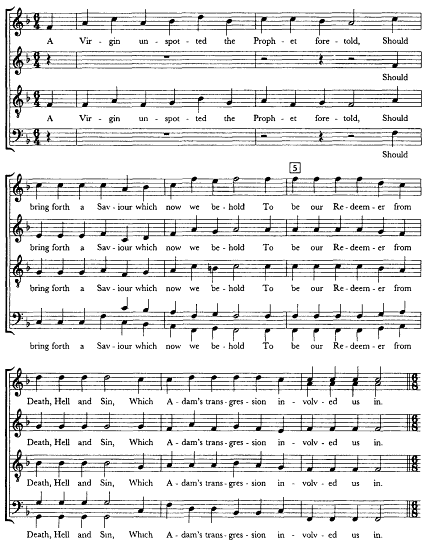
Example 11.
Billings, JUDEA (unknown) (Singing Master's Assistant [1778];
after Nathan, ed., Complete Works of William Billings, vol. 2, 52)
(continued )
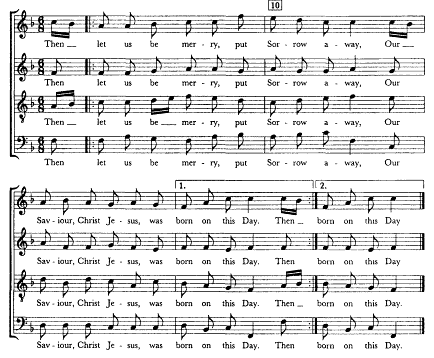
Example 11
(continued)
he had taken his Billings pieces not from the composer's own Massachusetts-published works but from Jocelin, a Connecticut source. Thus, we have it on Thomas's own authority that Jocelin was the link connecting Billings to The Worcester Collection (see table 3E), itself the source for so many later compilers' choices.[41]
More could be explored about the dissemination of Billings's music: about how the core of tunes that moved from The Singing Master's Assistant to Jocelin to The Worcester Collection was modified in later editions of that work; about The Worcester Collection's introduction, which named and praised Billings as chief among New England composers, hence proposing his books as a field for more borrowings;[42] about the article in the Philadelphia Columbian Magazine in 1788 that puts Billings in the artistic company of Handel and Shakespeare and surely led to the appearance of so much of his music in the Selection of Sacred Harmony
of that and later years.[43] But for now we'll have to be satisfied with having sketched the process by which Billings's pieces came to account for nearly 20 percent of the compositions in the most successful and influential American sacred tunebook of the decade.
This chapter has taken as its starting point Oscar G. Sonneck's maxim that "bibliography is the backbone of history."[44] Knowing which of Billings's pieces from The Singing Master's Assistant were printed, and when and where, has provided a start toward a broader investigation of psalmody's dissemination in print. By noting the roles sacred tune-books were expected to play—artistic, pedagogical, theological, commercial, even nationalistic—we have recalled some of the constraints within which their compilers made their choices and hence something of the context within which personal preference operated. By observing patterns of printings, we have seen that compositions can be considered not simply as independent items circulating on their own merits but also as members of larger clusters of pieces. Jocelin chose from Billings's The Singing Master's Assistant a group of pieces complementing each other so well that they formed a well-rounded, nearly complete microcosm of Billings's settings of sacred verse. Learning this, and having retraced some of the steps by which it came about, reminds us that, in the subsistence economy of the tunebook world, dissemination took place in a field of resistance. New pieces appearing in the field were accepted or rejected partly on their intrinsic qualities and partly on their relationship to the pieces already there. Knowing something of the nature of those relationships in the field we are studying, whatever it may be, is a necessary step if we are to take dissemination as an issue worthy not only of description but of analysis.
5
George Frederick Root (1820-1895) and American Vocal Music
George Frederick Root, a true man of the people, was, with Lowell Mason, among the first American musicians to discover the full rewards of reaching those people. Born on a Massachusetts farm, Root spent his professional life chiefly in Boston, New York, and Chicago. Yet he held fast to his rural origins. In mid-career, he moved from New York City to the Massachusetts hamlet of North Reading, where he had grown up. There, he later recalled, he drew inspiration from "the thoughts that came amid the pleasant scenes that surrounded me," just as, a few years later, the Illinois plains—his "first sight of the West"—again stirred his creative impulse.[1] When Root began his musical career, most Americans lived in small towns or on farms. As he told the story, his professional success was that of a "country boy" who loved the rural landscape and never lost his kinship with those who dwelt in it.[2]
Root was a prolific musician and author whose publications leave a detailed record of his activities.[3] But the key to his character and achievement lies in the autobiography published when he was seventy-one. According to its preface, this work was inspired by a family gathering on the fiftieth anniversary of the day he left home to seek his fortune in Boston (1 October 1888). The autobiography, cheerful and straightforward in tone, proceeded from a memory sharpened by a lifetime of recording personal observations. For Root was a diary keeper whose day-to-day record, begun in the 1840s, perished in Chicago's Great Fire of 1871.[4]The Story of a Musical Life is invaluable as an account of the musical worlds Root helped to create and his activities within. them.
Absorbing too, and equally revealing, is Root's autobiographical self-portrait. The farm boy, he recalls, was not left to discover music on his
own. His father and mother were musical; he had siblings, a brother and a sister, who became professional musicians; he learned as a youngster to play the flute and other instruments; and from early childhood, "the dream of [his] life was to be a musician."[5] (Root omits mentioning that his parents named him after Handel.)[6] On the other hand, his formal education was limited to grammar school; he never played an organ or piano until he went to Boston at eighteen; and, although he won national fame as a vocal teacher, he was not naturally gifted as a singer. "I had occasionally joined in the base of simple church tunes," he confides, "but was never encouraged by listeners to continue my performances long. They'd say, "George, you'd better [get] your flute."[7]
Implicit in this story told on himself, and present throughout his chronicle, is Root's sense of social belonging. When he decided to move to Boston to study music, there was "great excitement" in North Reading. Root recalls that he "went around telling the good news to interested and sympathizing neighbors. All met me with good words. 'Go ahead!' they said; 'we'll lend a hand on the farm, if we're needed.' "[8] Thus, Root went to Boston not as a young artist escaping a philistine environment but as a proud representative of his family and home town. Together with his own hopes, he took with him the blessings of fellow townspeople, who liked him but, like himself, harbored no illusion that he was a genius.
In the preface to The Story of a Musical Life , Root begs forgiveness in advance for "the apparent egotism" a reader might find in "certain sayings and events which refer to myself and my career." They are included, he explains, because "my story would not be complete without them." At first glance, this comment might have the look of false modesty. But in fact, Root's insistence upon his own ordinariness, his refusal to claim any special gifts or talents, is one of the chief themes of his book. The leading character in Root's autobiography is a man in tune with society, sharing its tastes and working cheerfully and effectively within the musical life of a democracy.
Root's story, then, has little connection with the struggle between good and evil in which some of his Calvinistic forebears believed themselves engaged. But at one point, evil does put in an appearance, and that episode provides a revealing glimpse of Root's sensibility. The perpetrator was Henry Russell, "an English Jew" whose songs Root admired and learned to sing and play as a young man. When Russell
performed in Boston in 1839, the nineteen-year-old Root was deeply impressed.
He had a beautiful baritone voice and great command of the keyboard—played his own accompaniments, gave his concerts entirely alone, and in a year in this country made a fortune. Songs of his, like "The Maniac" and "The Gambler's Wife," were exceedingly pathetic, and always made people cry when he sang them. He looked so pitiful and so sympathetic—"he felt every word," as his listeners would think and say.
Then Root found out that Russell's sincerity was an act. "When he retired to his dressing room," Root learned, Russell "was said to have been much amused at the grief of his weeping constituents." Root could neither accept nor forgive such cynicism. "Good taste," he declared, "requires that the singer should treat respectfully the emotion he excites."[9]
Root's condemnation of Russell brings into focus the ethical side of his own code of professional behavior. In Root's mind, to make a profession of music, whether as a teacher, a composer, or a performer, was to strike a bargain with the public. When members of that public became his customers, he felt bound to respect them and their responses to his work. Russell, by harboring contempt for his audience's sentimentality, mocked their trust in him. Root, on the other hand, refused to allow any such gap to open up between him and the people whose musical needs he served. With memories of his own modest origins and background as his guide, he held fast in private to the taste he espoused in public. Shortly before The Story of a Musical Life appeared, W. S. B. Mathews confirmed Root's success. Writing as if the elderly composer were a beloved uncle, Mathews called him "one of those personages who have so grown into American life . . . through his work" that when he dies "each will feel that he has in some way . . . sustained a personal loss."[10] Root's bargain with his audience struck a balance that, for a man of a different time or place, or of less genuine modesty, would have required a major exercise of vigilance and willpower.
For all the genial tone in Root's autobiography, it is by no means free of conflict. From its early pages, Root carries on an argument, not with the likes of Henry Russell but rather with an attitude widespread
among musicians in the cultivated tradition. The more technically accomplished they are, Root notes, the more strongly musicians tend to identify themselves with music as an art form evolving apart from the needs and wishes of most members of society.[11] In other words, musical talent, training, and experience, as they are more and more fully developed, breed a sense of autonomy. For musicians in the United States, however, intellectual autonomy bears little or no relationship to material well-being. To believe that it can form the basis for a musical career is a dangerous illusion. The Story of a Musical Life cites many examples of the autonomous attitude, including Root's own encounters with it.[12] Root never argues against elaborate music, for by any measure he qualifies as a lover of the classics. Beethoven and Wagner, for him, are the two geniuses of the century, Handel's Messiah and Mendelssohn's Elijah masterworks that sustained him throughout his life.[13] But as he saw the matter, his own professional choice and that of most of his American colleagues lay between serving the art of music and serving the musical needs of his fellow citizens. Root's experience taught him that "a majority of the music-loving world" enjoyed only an "elementary" state of musical knowledge. Their love for the art, he believed, was no less genuine for its "elementary" character, nor was their taste to be despised, for "all must pass" through the same levels. Moreover, Root discovered, identifying and addressing "elementary" musical needs could be a challenging, absorbing enterprise—indeed, an honorable lifelong mission.[14] In a sentence that could make a fitting epitaph, Root wrote: "I am simply one, who, from such resources as he finds within himself, makes music for the people, having always a particular need in view."[15]
Root's musical career divides into distinct phases. During his early years in Boston (1838-44), he made himself, through diligent labor and natural gifts, into an effective teacher. He moved to New York (1844-55), and there he hit his professional stride. In his New York years, Root taught singing classes, played the organ and conducted church choirs, and began the activities that were to dominate his later life: composing; participation in conventions and "normal institutes" for the training of music teachers; and compiling collections of vocal music. There followed a move to the country—to a house his musical success
enabled him to build for his family in North Reading, where he had grown up. For several years, "Willow Farm" was Root's headquarters, as he gave up singing classes and church work, devoting himself entirely to "conventions, Normal [Institutes], and authorship"—that is, composing and compiling tunebooks.[16] By 1859 the bucolic interlude had run its course. Root moved west and spent the next dozen years as a partner in Root and Cady, a Chicago music publishing house founded by his brother. Here he showed his mettle in the competitive world of the music business. The destruction of Root and Cady's physical plant by the great Chicago fire of 1871 brought this phase of Root's career to a close. From that time until his death in 1895, he stayed in Chicago, resuming his earlier round of normal institutes, compiling, and composing.
Success came quickly to Root. Within weeks of his arrival in Boston as a rank beginner, he was ordered by his first mentor, A. N. Johnson, to begin teaching an even ranker beginner. And not long after beginning the struggle to make his "large, clumsy fingers" negotiate a keyboard,[17] he was playing the final hymn in church services, apparently so the regular organist could leave to play another service. He explained his quick acceptance into professional ranks as more a matter of opportunity than talent.
If my getting on so fast in a city like Boston seems unaccountable, I must explain again that music [in 1840] was in a very different condition then from what it is now. It was just emerging from the florid but crude melodies and the imperfect harmonies of the older time.[18] Lowell Mason had . . . just commenced what proved to be a revolution in the "plain song" of the church and of the people, and his methods of teaching the elementary principles of music were so much better . . . than anything . . . seen [before] that those who were early in the field had very great advantage. We had no competition and were sought for on every hand.[19]
From that time on, Root displayed a shrewd sense of his own gifts and a knack for choosing things he could master. His competence as a teacher is proved by his entry into the circle headed by Mason.[20] But teaching was not enough to keep the energetic Root occupied for long.
Early in the 1850s, at the age of thirty-one, he began to compose. Looking back on his musical life, he admitted in his autobiography that he had "never felt" he "had a 'call' to be a musical composer." He was drawn into composing, he said, "to supply my own wants." Only after his compositions were "successful for myself and others" did he decide to take composing seriously. "I can truly say," he wrote, that "I never dreamed of eminence as a writer of music, and never had fame for an object."[21]
Root expressed no regrets about his late entry into the domain of musical composition. "I have often been glad that I did not begin earlier to write for publication," he claimed. "By delaying I had become better equipped. I had heard a good deal of good music, and had been obliged to teach some of a high order.... The reservoir was, therefore, much better filled than it would have been if I had commenced when [first] urged to do so."[22] One experience that helped to fill the "reservoir" was a nine-month trip to Paris (December 1850-August 1851), where Root took lessons in piano and singing and heard many concerts. Returning in the fall to New York City and to his duties, which included daily singing classes given to hundreds of "young ladies of culture and refinement"[23] at two female seminaries, he felt the need "for something new" for these classes. Deciding that "a little musical play . . . made for girls and young ladies . . . [might] be useful," he "cast about for a subject. It was not difficult to find one; the whole world was open to me, for nothing of the kind had been done. I soon decided that the subject should be flowers choosing a queen, and that the little play should be called 'The Flower Queen.' "[24]
Root set out to compose, then, as a mature man, experienced in teaching and performing but without formal training as a composer.[25] He didn't need it. Finding a local poetess, Fanny Crosby, "who had a great gift for rhyming," and "a delicate and poetic imagination," he set to work.
I generally hummed enough of a melody to give her an idea of the meter and rhythmic swing wanted … The next day the poem would be ready … After receiving her poems, … I thought out the music, perhaps while going from one lesson to another … and then I caught the first moment of freedom to write it out. Sometimes this was a half hour before dinner or supper,
sometimes a little while between lessons, and sometimes an hour at night. This went on until the cantata was finished.[26]
Needing hundreds of copies of the new cantata for his students, Root arranged for The Flower Queen to be printed, although he had no thought "that it would ever be heard outside of the walls of the institutions in which I was teaching." His publishers, Mason Brothers of New York City, decided it was worth a risk. "We'll publish it regularly," they told him: "others may want what you want."[27] And so they did. The Flower Queen was published and performed, and it succeeded. Others did want what Root wanted; the career of an American composer had begun.[28]
Inspired by the melodies of Stephen Foster, Root next began writing songs—"people's songs," as he called them. In this field, in sharp contrast to that of The Flower Queen , Root had many competitors. But again he succeeded. Two of his early songs, "The Hazel Dell" (1852) and "Rosalie, the Prairie Flower" (1855), became hits.[29] Let's look at a pair of Root's songs from 1852, written at the beginning of his career as a song composer. The first, a copy of a much more famous one, was a failure. But the second was a success whose brisk sales helped to elevate the erstwhile farm boy to the ranks of North Reading's gentry by the time he was thirty-five.
Even if Root had not acknowledged the source of his inspiration, it would be hard to miss the resemblance between his "The Old Folks Are Gone" (1852) and Foster's "The Old Folks at Home" (1851). Similarity of title and subject aside, Root's text and declamation follow Foster's almost exactly (ex. 12a).
FOSTER | Way down upon de Swanee ribber, |
Far, far away. | |
ROOT: | Far, far in many lands I've wandered, |
Sadly and lone. |
Echoes of Foster's text resound in Root's even though Foster's song is written in the dialect of the minstrel stage and Root's is not. Foster's "There's where my heart is turning ever" becomes Root's "My heart was ever turning southward"; Foster's "All de world am sad and dreary" in the chorus becomes "Here I wander sad and lonely"; and Foster's

(a) Bars 9-12, vocal part (New York, 1852)

(b) Bars 25-32, vocal part (New York, 1852);
fermata added by original owner
Example 12.
G. Friedrich Wurzel [George Frederick Root],
"The Old Folks Are Gone" (Root?)
characteristic words "weary" and "roam" both appear in Root's song. In the second stanza, the modeling is no less obvious:
FOSTER : | When I was playing wid my brudder, |
Happy was I. | |
Oh, take me to my kind old mudder, | |
Dere let me live and die. | |
ROOT: | Here's where I frolick'd with my brother, |
Under the tree. | |
Here's where I knelt beside my mother, | |
From care and sorrow free. |
Foster's hand-in-glove fit of words and music—which is the hand and which the glove?—marks "The Old Folks at Home" as superior to "The Old Folks Are Gone." One detail in a surviving copy of Root's song dramatizes the distance between the master and the novice at this stage in his career. On the last page, at the words "all, all the old folks are gone," an early owner of the sheet music has added a fermata, trying to ease the awkwardness of Root's climactic leap of a seventh (see ex. 12b).[30] (In contrast, the octave leaps in Foster's melodic line convey grace and ease, even inevitability.) The song's cover identifies it with E. P. Christy, who headed a leading New York minstrel troupe.[31] William
Austin has written that Root's song "was sung by Christy, but not often."[32] "The Old Folks Are Gone" is one of thousands of would-be American popular songs that were ignored by the populace.
Example 13, a song from 1852, received a much warmer response than did Root's "Old Folks" imitation. "The Hazel Dell" marked the first time Root managed a feat that he admitted always remained a mystery to him: He had composed a successful "people's song"—a song, as he put it, that "boys whistled . . . and . . . hand organs played . . . from Maine to Georgia." In Root's opinion, "no ambition for a songwriter could go higher than that."[33] How had he accomplished it? Root wasn't sure.
It is easy to write correctly a simple song, but so to use the material of which such a song must be made that it will be received and live in the hearts of the people is quite another matter . . .. It was much easier to write where the resources were greater; where I did not have to stop and say, "That interval is too difficult," or "That chord won't do."[34]
Root's description of how he wrote his Civil War songs shows that by the early 1860s he had a method for courting inspiration; but perhaps he discovered that earlier in his song-composing career. Beginning with words and phrases in mind, he relied on a technique he had developed while teaching singing classes—classes, he wrote, "that could be kept in order only by prompt and rapid movements." "I found my fourteen years of extemporizing melodies on the blackboard . . . a great advantage. Such work as I could do at all I could do quickly. There was no waiting for a melody. Such as it was it came at once, as when I stood before the blackboard in the old school days."[35] Thus, Root seems to have composed his "people's songs," within "the land of tonic, dominant, and subdominant,"[36] by fitting text to melodic phrases that sprang into his mind, as melodies always had when he improvised them for his singing classes. Once the melody had taken shape, he purged it of infelicities, removing anything that might make it too complicated to sing. As Root described it, composing songs was a direct extension of his work as a practical musician: a process of conception, virtually at the level of trained reflex, followed by reaction and retouching. Though he doesn't put it quite this way, Root writes as if, rather than
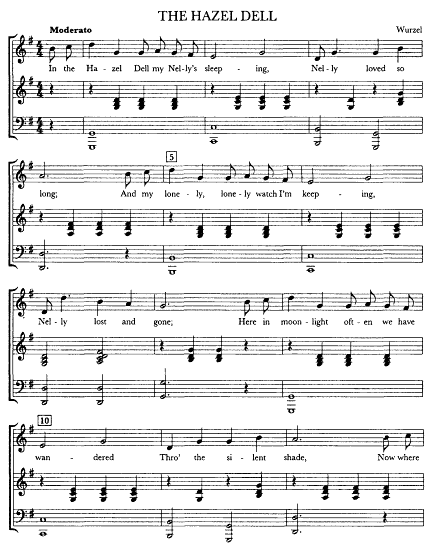
Example 13.
G. Friedrich Wurzel [George Frederick Root], "The Hazel Dell" (Crosby)
(New York, 1852); after George F. Root, The Story of a Musical Life:
An Autobiography (Cincinnati, 1891), 234
(continued )
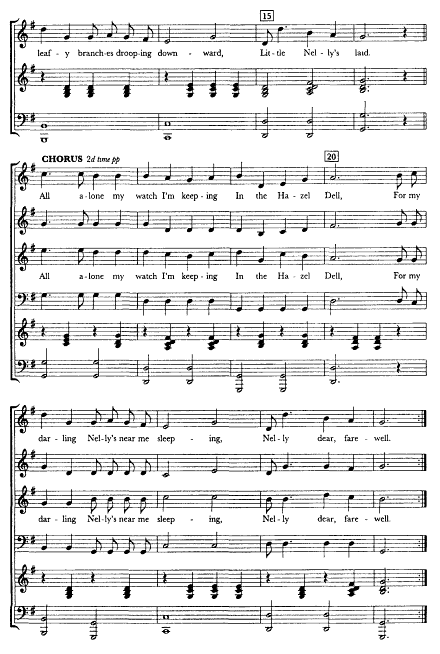
Example 13
(continued)
constructing songs as a self-conscious craftsman, he found them, coming upon tunes, and sometimes texts as well, in his creative "reservoir." He once described Henry Clay Work (1832-84), whose songs Root and Cady also published, as "a slow, pains-taking writer, being from one to three weeks upon a song." Root admired his colleague's results. "When the work was done," he wrote, "it was like a piece of fine mosaic, especially in the fitting of words to music."[37] Yet Root's praise leaves the impression that Work's technique of writing songs differed profoundly from his own.
If Root referred to his musical imagination as the "reservoir" from which songs flowed, he says nothing in the autobiography about the reservoir's sources: the conventions that marked the boundaries of subject matter and diction within which he worked as a songwriter. According to Austin, "The Hazel Dell" belongs to the nineteenth-century Anglo-Irish-American genre of "poetic" songs—songs inspired by a parting or the passing of time and pervaded by a sense of dreamlike vagueness: a tradition in which "Oft in the Stilly Night" by Thomas Moore is linked with Foster's "Jeanie with the Light Brown Hair."[38] Charles Hamm locates "The Hazel Dell" on the fringes of blackface minstrelsy, though it lacks dialect or any hint of buffoonery, placing it with songs about departed young ladies with Scotchsnappable first names: Hanby's "Darling Nelly Gray," Foster's "Gentle Annie," Thompson's "Lilly Dale" and "Annie Lisle," Winner's "Listen to the Mocking Bird" ("I'm dreaming now of Hallie . . .").[39]
Austin is no admirer of "The Hazel Dell," comparing it unfavorably with Foster's "Lily Ray" (1850) and finding it "a hasty and mechanical imitation of Foster's style."[40] "The melody," Austin writes, "seems cramped in its octave range; it strikes its highest and lowest notes in every phrase, and treats most of the notes between them as mere decorations of the central keynote." And he goes on to call the rhythm "plodding."[41] With all respect for the opinion of this knowledgeable observer, I think the song's first four measures are enough to explain its appeal. Certainly that appeal does not lie in the harmony, whose only inventive touch lies in the bass's movement to B in bar 3. Most of all, the opening makes its mark through the flexible rhythm of its declamation: the pushing forward of the first five beats, the coming to rest on "sleeping," and the syncopated hitch with which "Nelly" sets the
second half of the phrase into motion. The varied movement within each of the phrase's four bars gives a certain plasticity to its melodic curve. That, coupled with the economy of the text, which, in just eleven words, reveals a glen in the country, a dead maiden, and a grieving lover, were apparently enough to propel "The Hazel Dell" to wide acceptance. It's noteworthy that almost everything in the song has happened by the fifth bar. The rest of the text offers no narrative. It simply elaborates physical and emotional details of the melancholy scene. The music follows suit: Five of the six phrases in each of the three stanzas are sung to the opening melody. Text and music combine to produce a single mood, static as a picture hung on the wall or a quiet pool in the woods. "The Hazel Dell" suggests how much a "poetic" song's success could depend upon catching a mood in one quick, convincing gesture. Once caught, the mood is fixed and meditated upon through virtually unvaried repetition.
What made a song like "The Hazel Dell" appealing to the public who bought so many copies? According to no less an authority on public taste than the English publisher John Curwen, Root and other Americans composing in a similar vein had happened on to a unique, socially useful musical style. As Curwen wrote Root in the 1850s, "We have in England plenty of high-class music, and more than enough of the Captain Jinks kind of songs, but there is a wholesome middle-ground in regard to both words and music in which you in America greatly excel."[42] Curwen's comment suggests a split in English music between "high-class" compositions for the concert hall and opera house and comic songs, presumably of the kind that flourished in music hall performances. The "wholesome middle-ground" Root had discovered in a song like "The Hazel Dell" was both stylistic and social. Less elevated than an aria, more decorous than a comic song, "The Hazel Dell" was not, like most English and American-published songs of the time, composed for theatrical performance. Bone simple, musically and emotionally redundant, "The Hazel Dell" could easily be sung and played by inexperienced amateurs. And indeed, it was primarily for singing at home that it was composed. In one sense, it can be considered a secular counterpart to the hymn tunes Lowell Mason composed, selected, arranged, and published for the new musical customers he began to discover in the 1820s—a musical product fabricated within rigid, market-
inspired conventions. But that view hardly explains why a song like "The Hazel Dell" could make an impact on many Americans.
Historians have advanced reasons for the appeal of such songs, including public naiveté, bad taste, and the absence of alternatives.[43] But such explanations are inclined to treat a song as an independent work of art—one to be judged against songs already in the canon, and hence definers of its "song" norm, which is believed to transcend questions of time and place. By thinking of "The Hazel Dell" as an occasion for experience in its own historical setting, however, one occupies a better position for glimpsing its expressive potential—its ability, in Root's phrase, to "live in the hearts of people." Those people, presumably, included both performers and listeners. From a singer's point of view, "The Hazel Dell" presents an emotional situation as uncomplicated as its musical challenge. The persona of the narrator, into which the song invites the singer to project himself (or herself), is lonely and grieving; but these emotions are expressed in a highly stylized way. In American "poetic" songs of this period, grief is conveyed through words, not music. Musical resources that, at least as far back as the sixteenth century in Europe, have evoked sadness and pain—minor mode, chromatic adventures in melody and harmony, shifts in tempo to reflect unstable emotions—are nowhere to be found in these "people's songs." Here, moods ranging from ecstatic joy to profound melancholy are all set in major mode (as, indeed, are almost all of Stephen Foster's songs). Songs of grief are slower in tempo and declamation than songs of joy. But except for that contrast, and perhaps the character of the piano accompaniment, the chief difference between them lies in their words.
As these remarks suggest, although American "people's songs" of the nineteenth century collectively cover a wide range of emotions, individual songs seldom do. In fact, most are free of emotional complexity. When they do express grief, as in "The Hazel Dell," they do so in a way seemingly drained of passion. Whatever the words assert about the singer's state of mind, the music conveys a clear sense of distancing from the experience, a kind of escape in which, rather than grappling with the sense of loss in the text, the music lyricizes it. Absorbing, diffusing, and generalizing the emotional sting of the laments offered up in such songs, the music has the effect of removing them from the present. Rather than passionate outbursts, they become gentle,
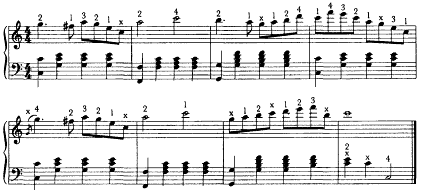
Example 14.
George F. Root, "Kiss Me, Mother, Kiss Your Darling!" (Lord)
(New York, 1864), William L. Clements Library, University of Michigan
often dreamy reveries. While the foregoing may not explain the genesis of this brand of song in mid-nineteenth-century America, it does help to suggest its wide appeal. Coupled with a lack of musical complication, the emotional straightforwardness of the "poetic" song removed any technical or expressive barriers that might have deterred amateur performers from singing and playing these songs. If assuming a "dramatic" role, however momentarily, was part of what encouraged Americans of Root's day to take part in parlor singing as a form of expressive activity, then the role offered by "The Hazel Dell"—dignified, sensitive, wistful— could be slipped into and out of with ease.
Example 14 is offered here as a glimpse into the world of Root's customers. To look at this copy of "Kiss Me, Mother, Kiss Your Darling!" is to sense the earnest anxiety of the pianist who took the trouble to finger the introduction so carefully. We imagine the experience performing must have been for this musician: a tense journey through the intro, strewn with eighth notes and perilous jump-bass chords; relaxation when the simple boom-chuck harmonies arrive in support of the singer's entrance; rising tension as the end of the chorus approaches and the challenge of the introduction, to be played "tenderly," looms again.[44]
But the issue here is not one performer's skill or lack of it. It's the circumstances for which Root's songs were intended. "Kiss Me,
Mother," "The Old Folks Are Gone," and "The Hazel Dell" were only three drops in the ocean of songs and instrumental pieces composed or arranged in the mid-nineteenth century with American amateur performers in mind.[45] Set down in notation and sold in sheet-music form, accompanied by the piano—which by the 1840s had been redesigned and was beginning to be successfully merchandised as the American parlor instrument[46] —these songs mark the emergence of the middle-class American home as a center of musical performance and a prime target of the music business. In the first stage of his career, focused upon teaching classes and group performance, Root carried on, in modernized form, the tradition of the old singing school. Beginning in the 1850s, his composition of songs for home performers brought him into a new arena, perhaps the most volatile, competitive field of the American music business of that day.
Of all the things that historians have noted about Root, one that few have missed is that he used an assumed name as well as his own. The composer of "The Old Folks Are Gone" and "The Hazel Dell" is listed as G. Friedrich Wurzel. Get it? George Frederick Wurzel, the latter meaning "root" in German. It was under this German pseudonym that Root began to write and publish his solo songs. It has been suggested that Root did so in the hope that the name of a German composer might boost the sales of his music.[47] And that interpretation is surely consistent with what is known about the American musical scene in Root's day, including its strong strain of commercialism and the prestige a European pedigree carried. But if one takes the pseudonym as a comment on the structure of mid-nineteenth-century American musical life, another element comes more sharply into focus. By recognizing that when Root began to compose solo songs he began moving away from his professional home base, we can see the Root-Wurzel dodge as evidence of a contrast between musical worlds. The world of teacher-compiler George Frederick Root was one of singing classes, instructional tunebooks issued by book publishers, moral inculcation, invocations and benedictions, and choral performances whose pinnacle of aspiration lay in oratorio excerpts. The world of song-composer G. Friedrich Wurzel centered more on performance by individuals, on sheet music from music publishers, on parlor singing for recreation and enjoyment, and on bringing stage works—from opera to blackface minstrelsy—into the home circle. The latter's secularity and unabashed commercial orien-
tation made it suspect to some who gravitated toward the former, devoted as it was to edification and things of the spirit. When we recall that in Paris in 1851 Root had felt compelled to refuse an invitation to the opera because his church forbade its members to attend the theater,[48] the pseudonym—whether a serious attempt to protect a respected name or a more playfully offered disguise—is not hard to understand.[49]
Beginning in 1852 and continuing for some years thereafter, Root maintained two personas, each with its own identity, separated not only by vocational emphases and institutional bifurcation but by musical style. Root dramatized their separateness by maintaining his career as a teacher-composer while continuing to write popular songs under a different name.[50] And this brings us to The Haymakers , composed in 1856 by Root, not Wurzel, the fourth cantata in the line that followed The Flower Queen .[51]
The Haymakers came straight out of Root's own boyhood experience. He wrote it, words and music both, in his library at Willow Farm, where, he recalled:
by stepping to the door, I could see the very fields in which I had swung the scythe and raked the hay, and in which I had many a time hurried to get the last load into the barn before the thunder-storm should burst upon us. In fact, nearly every scene described in the cantata had its counterpart in my experience on the old farm not many years before.[52]
Calling his piece "an operatic cantata," Root published it with detailed directions for costuming and staging, even to the point of describing how to make, from walnut shells, parchment, and catgut, an imitation katydid to contradict the city-slicker, Snipkins, in one of his songs. (Snipkins: "Sweet Kate never loved anybody but me!" Katydid: "Katydid, Katydid, Katydid." Snipkins: "Katy didn't.")[53]
During Part I of The Haymakers , a crew of happy workers is assembled, mows the hayfield, then beds down for the night to the strains of a choral lullaby. Part II traces the next day's events, beginning with "Good Morning" (ex. 15), a spirited part-song in praise of the dawning of a new summer day. In its ABA form the chorus is straightforward and conventional. In texture it is not, for Root overlays the choral block
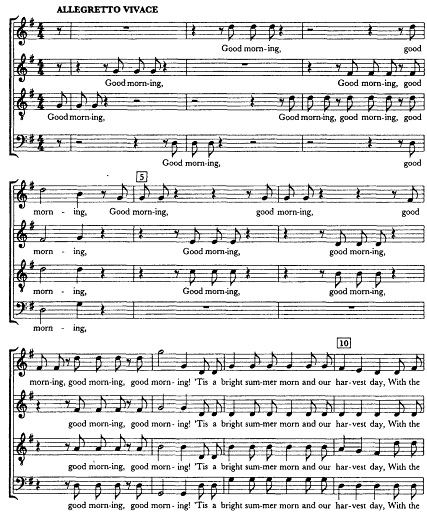
Example 15.
George F. Root, "Good Morning!" bars 1-22 (Root)
(The Haymakers [New York, 1857], No. 23, p. 44)
(continued )
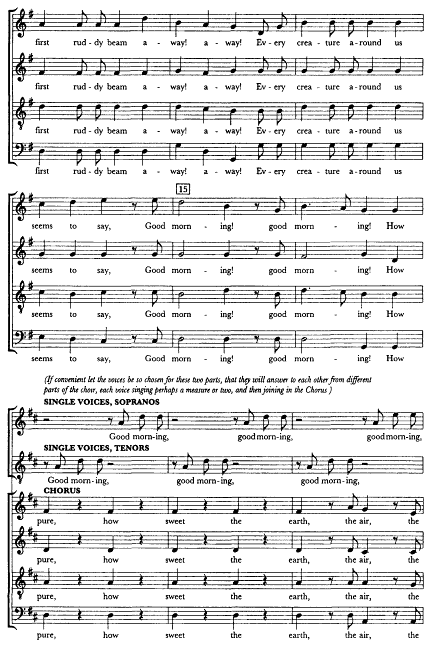
Example 15
(continued)
(continued )
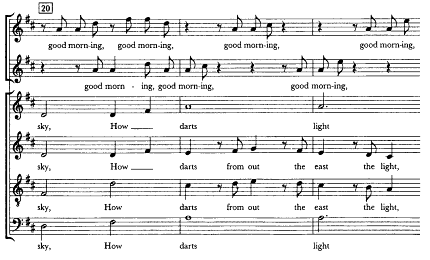
Example 15
(continued)
chords with patter divided among a gaggle of solo voices. The conversational, chattering quality of the solo singers, filling the gaps in the larger chorus's sound, creates a mood of youthful effervescence that seems especially suited to light, untrained voices—presumably those of the singers for whom The Haymakers and other works like it were composed.
The chorus "Shrouded Is the Sun" presents the work's chief dramatic crisis. Haymakers need the cooperation of the weather. They cut the grass in sunshine and warmth. Once it's been cut, they hope the weather holds until the grass has dried into hay, been collected into bales, and safely stored in the barn. In Root's drama, the sky darkens during the gathering, and the workers rush to finish the job. Just after the barn door closes on the new crop, a fearsome storm breaks. And Root's musical treatment of it shows that by 1856 he commanded an idiom that went far beyond that of his Wurzellian "land of tonic, dominant, and subdominant" in an omnipresent major mode, with choruses in block chords and strophic repetition. Here the mode is mostly minor, as befits the subject, but with telling key changes. Opening in G minor, the chorus sings of the gathering storm, with "distant thunders" mur-
muring in the bass (bars 1-16; see ex. 16a). Then, hearing God's voice in the thunder's roar, it modulates to B-flat major as it marvels at his power. Scurrying sixteenth-note scale passages depict "the rushing, howling wind" in G minor (ex. 16b). The trees pitch violently. With the storm's full force about to break, the chorus's awe takes on a note of fear, and its harmonizing gives way to octaves (bars 51-52; ex. 16c). But suddenly, coordinating text, tonality, and texture, Root engineers an unexpected shift of mood. Instead of the chorus in full cry, a quartet of soloists, sounding as if offstage, offers a calming message in B-fiat (bars 52-60; ex. 16c): "Yet fear not we. He, whom the winds obeyed, is master of the storm."
From this point on, the piece is a dialogue between the chorus— louder, more and more agitated as the storm hits with full force, and always in G minor—and the quartet: calm, collected, and in the relative major. At the sound of a mighty crash of thunder, "earth trembles with afright." Then comes the rain, "in torrents pouring down." Finally, struck by lightning, a "mighty oak is riven in twain, as 't were a quiv'ring reed." But each new episode of violent destruction gets the same response from the quartet: we need not fear, for "the tempest but obeys" the heavenly father's will. The B-fiat episodes in the piece not only provide contrast; they intensify the impact of the G-minor sections. As the number ends, quartet and chorus join together for the first time, the former's message prevailing (in B-flat) as the storm loses force and dies away (ex. 16d).
In "Shrouded Is the Sun," Root shows himself able to spin out more than 120 bars of through-composed choral music packing considerable dramatic wallop. Here is the kind of piece—and there are others in the work—that moved John Sullivan Dwight, usually no fan of the Mason-Root school, to review The Haymakers favorably in 1859, commenting that it needed "only the addition of orchestral accompaniment to entitle it to the name of an opera."[54]
Root was not to do much more with his Haymakers style, which brought together elements of the reformed American hymn tune, the English glee, and the Mendelssohnian oratorio. Nor, after Belshazzar's Feast , a "dramatic cantata in ten scenes" (1860), was he to write another work in so rich an idiom. Instead, the events of the early 1860s brought him back to songwriting, this time with militant fervor. In the late 1850s, as convention trips took him more and more to Chicago, he had begun

(a) Bars 1-16, p. 71
Example 16.
George F. Root, "Shrouded Is the Sun" (Root)
(The Haymakers [New York, 1857], No. 36)
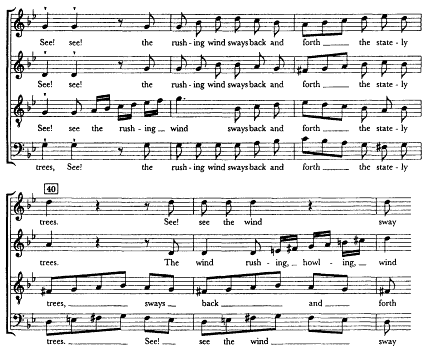
Example 6
(continued)
(b) Bars 37-42, P. 72
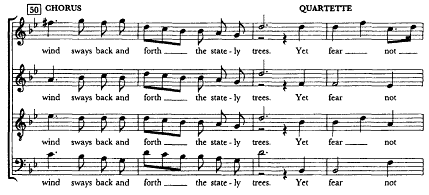
(c)Bars 50-60, p. 73
(continued )
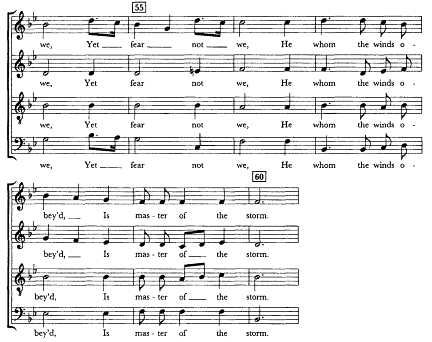
EXAMPLE 16
(continued)
"to play . . . at business" in his brother's publishing firm, and by the time he joined Root and Cady as a partner, he was publishing popular songs under his own name.[55] Root recalled his first years with Root and Cady as quiet ones: "We began to publish a little. First a song or two, and some instrumental pieces in sheet form. After a while we decided to venture on a book, and put in hand one that I was then working on for day-schools; but now the WAR burst upon us!" For the next ten years (1861-71) he found himself caught up in "a whirl . . . of hard and confining work."[56] Again, as in the past, he proved equal to the task that fate brought his way.
Root's description of how he "found" the melodies of his Civil War songs has already been noted. In writing their lyrics, he assumed the role of people's minstrel, seeking to capture and transmute the public's
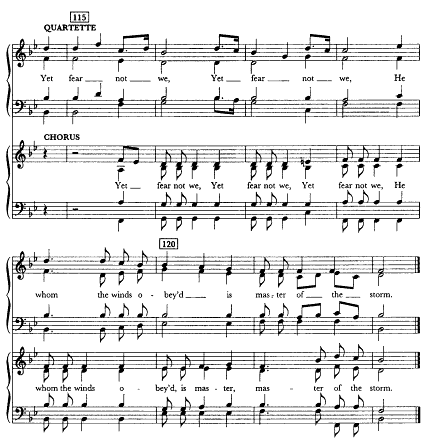
(d) Bars 114-22, p. 76
Example 16
(continued)
feelings. "When anything happened that could be voiced in a song, or when the heart of the Nation was moved by particular circumstances or conditions caused by the war, I wrote what I thought would then express the emotions of the soldiers or the people."[57] Root composed his war songs fully convinced of their moral and material worth in the cause. One Root and Cady advertisement called the songs "munitions of war."[58] "If I could not shoulder a musket in defense of my country," the composer later wrote, "I could serve her in this way."[59]
Root's "The Battle Cry of Freedom" reveals some of the properties that recommended it to those who sang and were stirred by it. One striking feature of this song is the comparative richness of the musical material itself, especially when compared with "The Hazel Dell." "The Battle Cry of Freedom" contains three distinctive, memorable ideas— "Yes, we'll rally round the flag," "Shouting the battle cry of Freedom" (ex. 17a), and "The Union forever" (ex. 17b)—more than the quota for people's songs in general, which could get by on just one. Since every phrase in the song is a statement or variant of one of the three, melodic energy stays at a high level throughout. Dotted rhythms on weak beats tie the three melodic phrases together; and the syncopation in the chorus on the song's highest pitch casts the word "forever" into relief, making it the song's climactic jolt. These elements are supported in the first, second, and fourth phrases by a harmonic twist that reaches beyond the "land of tonic, dominant, and subdominant." A little island of submediant follows the firm establishment of tonic; and after the D major (V of vi) in bar 5, the E-flat triad carries a nice ambiguity: possibly a deceptive cadence in G minor, but really the subdominant, restoring the B-flat tonic. When these musical details are linked with some of the resonant phrases in Root's text—each of the three main melodic ideas is set to a memorable text phrase—there is little mystery why this piece became the Union's most effective and popular martial song.[60]
Root's war songs explore the conflict from many angles. "The Battle Cry of Freedom" was written to inflame patriotic spirits at recruiting rallies.[61] "Just Before the Battle, Mother," in contrast, recounts a soldier's "thoughts of home and God" on the evening before he takes to the battlefield. Another Root favorite, "The Vacant Chair," sets the scene in the home of a soldier who's been killed in battle. ("We shall meet, but we shall miss him. There will be one vacant chair.") And "Tramp! Tramp! Tramp!" takes place in the cell of an imprisoned Union soldier as he anticipates the sound of the marching feet of his comrades, coming, he hopes, to set him free.
In "Tramp! Tramp! Tramp!" the sources that filled Root's "reservoir" of melody are not entirely mysterious (see ex. 18). The verse, from its opening gesture, to its continuation over a subdominant chord on the sixth degree, to its outright borrowing (bar 6, beat 4 to bar 7, beat 3) takes its impetus from the tune to which "The Battle Hymn of the Republic" was sung, right down to the key of B-flat, in which both were
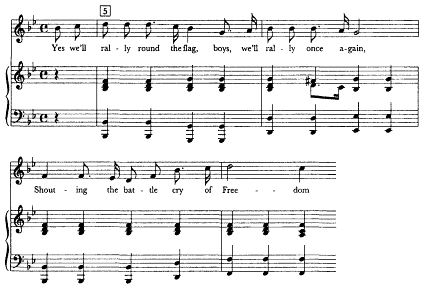
(a) Bars 4-8
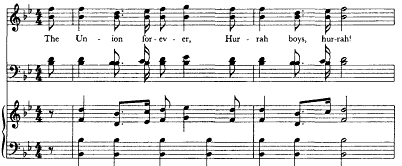
(b) Bars 12-14
Example 17.
George F. Root, "The Battle Cry of Freedom" (Root) (Chicago, 1862)
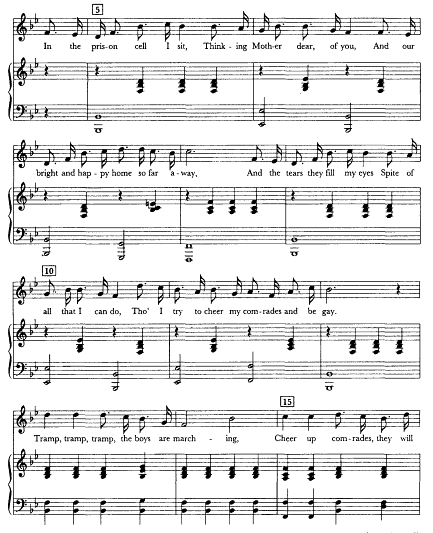
Example 18.
George F. Root, "Tramp! Tramp! Tramp! (The Prisoner's Hope),"
bars 4-20 (Root) (Chicago, 1864)
(continued )
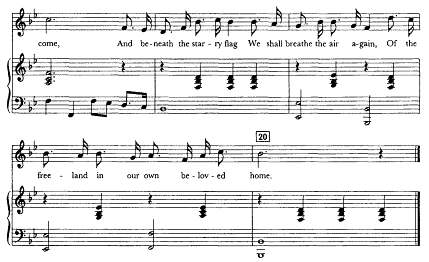
Example 18
(continued)
published as sheet music. As for the chorus, a story about that was told by W. S. B. Mathews in 1889. Speculating about the mysteries of popularity in song, he wrote:
Every popular melody will be found on examination to be very much like something else, generally like a melody by an older and more capable writer. A folks song, nine times out of ten, is a degradation of type, a feebler reminiscence of something better. Very many of the melodies of Mr. Geo. F. Root are very like parts of melodies in opera.
And then came Mathews's story, a parable on the perils of musical evangelism. It seems that William Mason, distinguished pianist and son of Lowell Mason, was once
sitting upon a hotel piazza watching some negro roustabouts unload the cargo of a steamer. As they worked they whistled or sang one melody, which seemed to him exactly like Verdi's anvil chorus [from Il Trovatore ], until a certain point was reached. At
this point they uniformly turned aside and ended Verdi's melody improperly. Hearing this for an hour or more finally awakened a missionary spirit in the conscientious musician, and he strolled down to the wharf to give the dusky singers a lesson, and secure artistic justice to Verdi's music. But when he began to teach them the correct interpretation, he seemed to them to be spoiling their melody, which upon further investigation proved to be Geo. F. Root's "Tramp, Tramp, Tramp, the Boys are Marching."[62]
Root was fifty-one when fire destroyed his business in 1871. Financially well off, he was widely honored as he approached old age, chiefly on the strength of his war songs.[63] On a trip to England in 1886, he was astonished to find that twenty-four pages of the library catalog of the British Museum were devoted to listings of his music.[64] As noted above, London publisher John Curwen had written him as early as the 1850s to compliment him on supplying "wholesome," accessible music for which the British Isles had no equivalent.[65] From that time on, Root's cantatas and songs began to be published in London. And on his trip he met English music teachers who had "taught and conducted my music, more or less, from the beginning of their work—indeed, as one said, some of them 'had been brought up on it' before they became teachers and conductors."[66]
Root's autobiography is filled with insights about the musical traditions in which he worked. While many elements of his world no longer exist, others have endured, and none more persistently than the need for American musicians to position themselves in the marketplace. Root's own success on that score was uncanny. In line with his pragmatic philosophy, his commitment to accessibility, to serving customers' needs in the marketplace, provides the framework for Root's professional life. Beyond that, however, the marketplace becomes an ideal: not just the arena where commercial transactions take place but the forum in which democratic consensus is shaped and registered. Once Root decided to compose for the largest possible number of customers, only the sales of his compositions in printed form and their performances in public and private venues could gauge his success accurately. Thus, The Story of a Musical Life depicts the marketplace as a positive force—the final
measure of achievement—not because it offers musicians a chance for commercial gain but because it is the incorruptible reflection of public judgment.
Root's experience taught him that the ultimate challenge of song-writing lay in outcomes beyond the composer's control. Reception, not composition, defined what he called "people's songs." As Austin has explained, Root's notion of "people's song" was "comprehensive." It encompassed many song genres: home and poetic songs, minstrel and other theatrical songs, patriotic and war songs, hymns and sacred songs, all of which had their own conventions, functions, and audiences.[67] Root enjoyed his first success as a composer, as we have seen, with The Flower Queen . Such pieces caught on with singing classes, providing unpretentious musical dramas well within the capacities of young, inexperienced singers. As artifacts to be sold, cantatas of this kind opened up a new niche in the marketplace, complementing the tunebooks already in general use. At the same time, works like The Flower Queen —"for the use of singing classes in academies," its title page noted—and The Haymakers remained solidly within the realm of instructional music. Published and marketed by Mason Brothers, a tunebook firm, they enriched the musical world that Root had entered when he arrived in Boston in 1838 without challenging its boundaries.
But the example of Stephen Foster showed Root that a much bigger arena lay open to the writer of solo songs. The songwriter's profession used sheet music, not tunebooks, to reach its public, and its purveyors were music publishers, not the tunebook firms who specialized in sacred and instructional music. Root composed "The Hazel Dell" under contract to the house of William Hall and Son of New York, known for effective marketing of sheet music through advertising and a wide network of selling agents. Hall boasted in 1856 that music from its presses could be had "from Maine to Oregon, the Sandwich Islands and Australia."[68] Considering, too, that song sheets were sold to individuals, not whole classes, at prices ranging from twenty to thirty-five cents— cantatas cost between sixty cents and a dollar—sheet music reached people who would never have bought tunebooks or cantatas. Root entered wholeheartedly into the songwriter's profession when success in its marketplace taught him that he had something to say to an audience more diverse than the congregations, singing pupils, and music teachers who had been his first customers. With "The Hazel Dell," "There's
Music in the Air," and especially his war songs, he achieved the ultimate goal of the popular artist: in the words of Greil Marcus, "to discover what it is that diverse people can authentically share." Novelist Raymond Chandler once noted the "vast difference between writing down to the public . . . and doing what you want to do in a form that the public has learned to accept."[69] Not a man to write down to anyone, Root made it a tenet of his professional life never to separate himself from the social order in which he lived and worked and whose taste he sought to please. From that grounding, he maintained a purity of spirit and intent that helped to fill the "reservoir" of musical imagination from which he drew his compositions.
Root's inability to explain his success as a song composer increased his respect for the marketplace. He confided: "I do not think a composer ever knows when that mysterious life . . . that power to retain their hold upon the hearts of the people . . . enters his work."[70] The story of how he composed his best-known hymn tune, "The Shining Shore," confirmed the mystery. One summer at Willow Farm, Root recalled:
Mother, passing through the room, laid a slip from one of her religious newspapers before me, saying: "George, I think that would be good for music." I looked, and the poem began, "My days are gliding swiftly by." A simple melody sang itself along in my mind as I read, and I jotted it down, and went on with my work. . .. Later, when I took up the melody to harmonize it, it seemed so very simple and commonplace that I hesitated about setting the other parts to it. But I finally decided that it might be useful to somebody, and completed it. . .. When, in after years, this song was sung in all the churches and Sunday-schools of the land, and in every land and tongue where our missionaries were at work, and so demonstrated that it had in it that mysterious life of which I have spoken, I tried to see why it should be so, but in vain. . .. I say so much about this little song because it is a particularly good illustration of the fact that the simplest music may have vitality as well as that which is higher, and that the composer knows no more about it in one case than in the other.[71]
In short, the vitality found in a true "people's song" is revealed only by the people's acceptance of it. And acceptance is measured by the
marketplace: the public tribunal to whose judgment Root learned to bow. Root launched his musical career as a teacher who, however modest his own knowledge, prospered by passing on what he knew to a public hungry for what he could give them. But the musical environment he lived in was more than a one-way street. The people, however receptive they might be to Root's teaching, also had something to teach him. For, expressing themselves as a collective entity in the musical marketplace, they could distinguish the few songs that deserved to live from the many that deserved oblivion. No one, including those who aspired to write "people's songs," could anticipate that judgment, nor could it be reduced to a formula or a theory. But neither was there any point in second guessing it.
As a teacher, then, Root gathered, structured, refined, and polished his musical knowledge, dispensing it in classes, conventions, "normals," and instructional books with efficiency and skill to a public of teachers and pupils who recognized his authority. As a song composer, in contrast, he worked quickly and spontaneously, then cast his bread upon the waters of the marketplace, hoping that he had captured something vital and enduring but fully aware that the results lay in the hands of public opinion. This dual relation to his audience—pedagogical authority and control, on the one hand, and compositional deference on the other—seems contradictory to a later age. Indeed, predecessors such as Thomas Hastings and Lowell Mason, contemporaries such as Stephen Foster, and later figures such as Theodore F. Seward and Charles K. Harris took one or the other of these stances but not both. Root and his generation seem to have been the first and last in which the two could combine in one person, suggesting an environment whose leaders understood knowledge and taste to be two different things, each with its own integrity.
Root's aspirations as a song composer affirmed his respect for the instinctive taste of the people. The Story of a Musical Life convinces the reader that, however he may have prospered financially from his musical strivings, Root gloried even more in his acceptance by those from whose ranks he had sprung and whose taste he shared, to his own benefit and to theirs.
6
Duke Ellington (1899-1974) and His Orchestra
Edward Kennedy Ellington once put the story of his life into two paragraphs.
Once upon a time a beautiful young lady and a very handsome young man fell in love and got married. They were a wonderful, compatible couple, and God blessed their marriage with a fine baby boy (eight pounds, eight ounces). They loved their little boy very much. They raised him, nurtured him, coddled him, and spoiled him. They raised him in the palm of the hand and gave him everything they thought he wanted. Finally, when he was about seven or eight, they let his feet touch the ground.
The first thing I did was to run out into the front yard, and then through the front gate, where I found someone who said, "Go ahead, Edward! Right over there." Once on the other side of the street, I ran into someone else who gave me the Go sign for a left-hand turn to the corner. When I got there, a voice said, "Turn right, and straight ahead. You can't miss it!" And that's the way it has always been. Ever), time I reached a point where I needed direction, I ran into a friendly advisor.[1]
Thus the words of a venerable black musician, an American institution by the time he published them in 1973. Ellington's words bring us into the presence of a powerful persona—a mask fashioned by an artist whose works included the public role he created for himself. "When I was a child, my mother told me I was blessed," he explained, "and I have always taken her word for it."[2] The character that Edward Ellington played in public, spoke through in interviews, and used to write his
autobiography was one of aristocratic confidence and grace. He was the Duke—the composer of hundreds of pieces who never seemed in a hurry; the black butler's son who talked with relaxed ease to audiences all over the world; the tough competitor in a cutthroat business who seemed unaware that he was competing at all. When Ellington lit up his famous smile and told an audience, "We love you madly," who were they to doubt him?[3]
Like many other things in Ellington's life, his persona has its roots in the central metaphor of his career: the tale of the favored child's journey. Mark Tucker's study of Ellington's beginnings in Washington, D.C., confirms his parents' key role. James ("J.E.") and Daisy Ellington, Tucker concludes, gave Edward "more than a sense of being well fed and much loved: they instilled in him a pride about who he was and what he could achieve."[4] The Ellington family's high expectations rubbed off on their son.[5] Asked late in life what had led him to begin composing "as a very young man," he replied: "The driving power was a matter of wanting to be—and to be heard—on the same level as the best."[6] Fueled by such aspiration, he set out on a lifelong quest to excel but with little technical training and no clear destination. That's where the "friendly advisors" came in. For at each crossroads, as Ellington faced a need for some new skill or a push in a new direction, he found help. Ellington's tale identifies two of the forces behind his accomplishments: competitive drive rooted in a deep hunger for personal achievement, and a gift, based on social shrewdness, for finding collaborators who could help him solve the problems he encountered.
Those who knew Ellington agree that he was a complex, enigmatic man.[7] Much the same could be said about his life's journey as a musician, for it led him to unexplored territory whose precise location remains a matter of disagreement even today, well into the second decade after his death. What did Ellington the musician really accomplish? Where did his journey take him? Clear-cut answers are hard to come by within our tradition of musicological inquiry. Just as Ellington's intense individualism and his easy sociability may seem contradictory rather than complementary impulses, it is not easy to fix his place in the world that music historians have rationalized for study.
Ellington's standing as a creator of music is one example of the problem. Gunther Schuller has called him "a major composer," indeed, perhaps "one of the half-dozen greatest masters of our time."[8] Major
composers, however, are usually thought of as people imbued with musical inventiveness, an instinct that appears early in life and persists thereafter; who seek and receive formal training, taking open pleasure in perfecting and exercising their craft; who work alone, courting inspiration and inventing structures of sound for performers to realize; and who "write" music, the verb implying both invention and the notation required to fix and preserve the music they create. Ellington's career contradicts these norms. He began sporadically, apparently composing his first piece at fifteen and writing songs from his mid-twenties on but concentrating on composing only after his career demanded it (he was twenty-seven at the time).[9] Except for a fairly brief period of harmony instruction from a Washington pianist and music master, Ellington was self-taught as a composer, and he showed no interest in discussing the technique of his art in public. (His resistance to more training later in life is a matter of documented fact.)[10] As for the notion of a composer working alone, significant parts of many "Ellington" pieces, especially their melodies, were contributed by other members of the ensemble.[11] Moreover, writing played only a small role in the creation of many Ellington compositions. Trumpeter Rex Stewart, who played with Ellington from 1934 to 1945, remembered the process of composition as it sometimes took place in the recording studio.
Ellington would usually arrive late, then warm up at the piano for a quarter-hour or so. If he played fast, the band knew it was to record a stomping, roaring piece; if he played slowly, they were to record a lament. Ellington would then invariably suggest to the musicians that they make sure the piano was in tune; this in fact meant that they themselves should be.[12]
When the musicians were tuned up, Ellington might then produce the score of his new "composition," most likely written on "some scraggly pieces of manuscript paper." Stewart remembered one session at which Ellington pulled out "about one-eighth of a page on which he'd scribbled . . . some notes for the saxophones . . . but there was nothing for Johnny Hodges. Duke had the saxes run the sequence down twice, while Johnny sat nonchalantly smoking. Then Duke called to Hodges, 'Hey Rabbit, give me a long slow glissando against that progression.' " Next, Ellington urged Cootie Williams to try entering "on the second bar"
of the passage with one of his patented trumpet growls. Then the leader turned to trombonist Lawrence Brown. "You are cast in the role of the sun beating down on the scene," he prompted. When that announcement brought no response, Ellington went on: "What kind of a sound do you feel that could be? You don't know? Well, try a high B-flat in a felt hat, play it legato, and sustain it for eight bars." Then, with these possible component parts in place, Ellington gave the downbeat and tried out the sound. The saxophone section played its melody, backed by the rhythm section and overlaid with Hodges's glissando, Williams's growl, and Brown's sun-warmed, muted B-flat. If the leader's guesses were on target and the men responded as he hoped, "the Ellington effect" might be invoked. "And," Stewart concluded, "that's the way things went—sometimes."[13]
On the occasion Stewart describes, Ellington composed not by drawing abstract tone combinations from his imagination but by working with his musicians so that their "tonal personalities"—their particular sound, way of playing, and inventiveness—actually helped to create the piece.[14] Perhaps the saxophone melody was his, perhaps not.[15] Certainly, Ellington determined the final result. But that result was the fruit of a collaborative encounter whose participants had already proved themselves unblendable individuals in Ellington's tonal coat of many colors. When trumpeter Fred Stone spent a few months in Ellington's orchestra in 1970, he was struck by the demands Ellington placed upon his musicians, far different from anything else in his experience.
The Ellington Orchestra is the only musical outfit I know where the members are hired solely on the basis of their strength and individuality. It is the only orchestra I know where you are not required to become an exact percentage of the section you're playing with; where you are not required to match the sound of the previous member. You must function as an individual—and you are judged solely on your personal musicianship.[16]
That is what Gunther Schuller seems to have had in mind when he noted Ellington's "unique" partnership with his players, in Schuller's view "unprecedented in the history of Western music." Ellington, Schuller writes, "forged a musical style and concept which, though totally original and individual, nevertheless consistently incorporated
and integrated the no less original musical ideas of his players."[17] Sound was surely foremost among those ideas. Stewart's description of Ellington at work demonstrates Schuller's point. For it was Hodges's glissando, Williams's growl, Brown's muted B-flat that gave Ellington the elements from which, with the help of his ear and piano, he molded his compositions.[18]
The gateway to Ellington's accomplishments as a composer, the seminal moment of arrival on his artistic journey, was the discovery by 1927 of "the Ellington effect"—the unique sound that was a product of his ideas about music, the "tonal personalities" of the players he hired, and the exploration he conducted of the sound possibilities of his own instrument, the piano.[19] The Ellington effect made the orchestra easily recognizable, a big advantage in the commercial environment in which Ellington worked. But the Ellington effect was more than a distinctive sound quality. It was a carrier of emotion through which he connected with his audience.
To the question of what Ellington accomplished as a musician, one of the most obvious answers is that he managed to stay in business as leader of a working jazz orchestra for more than fifty years. Only by finding and pleasing listeners could he have achieved such longevity. In Music Is My Mistress , Ellington leaves little doubt of his respect for audiences. Sometimes he describes himself as their servant: "I travel from place to place by car, bus, train, plane . . . taking rhythm to the dancers, harmony to the romantic, melody to the nostalgic, gratitude to the listener."[20] Elsewhere, he notes how rhythm can bring musicians and an audience into a state of profound, if short-lived, empathy. "When your pulse and my pulse are together," he writes, "we are swinging, with ears, eyes, and every member of the body tuned in to driving a wave emotionally, compellingly, to arid from the subconscious."[21] And sometimes, in his view, a knowledgeable audience can act almost like a skilled adversary who, by raising the competitive stakes, forces from the musicians the best performance they have to give.
When one is fortunate enough to have an extremely sensitive audience, and when every performer within the team on stage feels it, too, and reacts positively in coordination toward the pinnacle, and when both audience and performers are determined not to be outdone by the other, and when both have
appreciation and taste to match—then it is indeed a very special moment, never to be forgotten.[22]
Comments like these reaffirm Ellington's solid grounding in society. Banking his professional fate upon the musical personalities of his sidemen, he fashioned music for a social realm in which, by connecting emotionally with dancers and listeners, the music proved its worth.
It was Ellington's ability, first, to reach new audiences and, second, to employ the Ellington effect in new and different ways that kept him moving on his long, wide-ranging, and profitable journey. Rooted solidly in African-American culture, he began early in life to make music that reached beyond his own community.[23] And from November 1926, when Irving Mills became his manager, he courted new audiences on several fronts. In the United States sixty years ago, it was rare for black jazz bands to be listed in white record catalogs, to appear in Hollywood films, to perform in Broadway shows, or to receive prestigious bookings of the kind Ellington enjoyed when he played opposite French entertainer Maurice Chevalier at New York's Fulton Theater in 1930. Moreover, no other jazz ensemble, black or white, had a leader capable of producing a steady flow of new recorded compositions, much less one who—apparently at his manager's prompting—could write a "rhapsody" filling both sides of a 78-rpm disc. Finally, it was unusual, though not unprecedented, for black American ensembles to perform in Europe. With Mills's help, Ellington accomplished all these things by 1933.[24] Perhaps Mills's motive in each case was economic. But whatever the manager's goal, these challenges also had the effect of sharpening Ellington's technical skill and enlarging the expressive resources he commanded. Each, while broadening his audience, also enhanced Ellington's growth as an artist (and the artistic growth of his men) while at the same time undermining the public's notion of the boundaries within which black musicians worked. Mills's energetic pursuit of accessibility—his desire to reach a bigger and bigger audience on its own terms—had found a perfect foil: a group of black musicians, no less eager for popular approval than he, but with a leader whose music, at its best, struck a balance among three diverse forces: his own restless inventiveness, the imagination and skill of his players, and the audience's appetite for entertaining experience.[25]
What Ellington accomplished as a composer must be considered in light of that three-way relationship. Locating the balance point was Ellington's own doing. That he was able to maintain it over so many years is a tribute not only to his musicianship but to extraordinary personal qualities. In fact, the more closely one studies Ellington's career, the more clearly one sees his "enigmatic" personal complexity as an indispensable tool in the process of weighing, balancing, and negotiating that lay behind his rise to fame. Ellington described himself as an observer by nature, a trait he attributed to artists in general.[26] As a musician, he says, he was always an avid listener.[27] As an African-American, he became a close student of artistry in all its forms and an admirer of theatrical effects.[28] As a man, though to claim it for himself would be "square," Ellington was in all things "hip"—possessor of the quality he once defined as "up-to-the-minute awareness."[29] These traits helped him create an environment in which his players' tonal personalities could flourish, even in the face of a grinding year-round performing routine, while still satisfying an attentive, critical, dancing, listening audience.[30] Ellington's resources of character and personality left even those who knew him best in awe—reedman Otto Hardwick, for example, who grew up on Washington's T Street just a block away from the house where Ellington lived, and who played with Ellingtonled groups from the 1920s into the 1940s. "The amazing thing about him," Hardwick told an interviewer in the 1960s, "is that the language, the slant, everything, it's all acquired. It didn't rub off from someone else, and it wasn't a legacy, either. He went inside himself to find it."[31]
When Ellington began his professional life, the standard persona of black men in American show business was a shuffling, comic stereotype inherited from nineteenth-century blackface minstrelsy. Ellington rejected that stereotype, creating instead, surely with the help of Irving Mills, a dignified public image. In the. 1920s, an African-American artist with aspirations to compose found himself in what Lawrence Gushee has called a "mine field" of ideological polarities: "first of all," Gushee writes, the polarity of "classical and popular—that is to say, enduring and ephemeral, inspirational and industrial, idealistic and functional"; second, he continues, a black composer had to deal with the polarity of "Old Europe" and "New America"; and third was the "American polarity" of black and white.[32] During the first half of this century, African-Americans created, within the field of popular dance music, a
music that, if it did not demand, nevertheless invited the development of expert musicianship and intensity of musical expression.[33] This music, jazz, mediated between and among the existing polarities. Jazz, Gushee writes, was a music not for high financial profit, "yet not coopted by institutions, neither absolutely contemporary nor traditional, partly 'functional' and entertaining, partly not, and finally, neither completely black [nor white], American [nor] European."[34]
Ellington, as we have already seen, was one of the pioneers whose instinct for the delicate balance enabled him to flourish, even prosper, in the music business's "minefield." He succeeded, during the late 1920s and early 1930s, in forming and leading a successful dance orchestra, in making himself into an effective pianist, and in finding a personal voice as a composer. He accomplished these things not in seclusion but on the job, while leading his orchestra's nightly engagements. What he did was hard to do. But through his achievements, Ellington maintained an urbane, relaxed presence that concealed the difficulty of what he and his men were accomplishing.[35]
It was Billy Strayhorn, Ellington's close collaborator, who made the now-familiar observation that "Ellington plays the piano, but his real instrument is his band."[36] As leader of a band whose members, especially in earlier days, were not all schooled musicians or secure readers of music, Ellington was also a composer who worked in an improvisatory tradition. Of this polarity, Francis Newton has written that Ellington "solved the unbelievably difficult problem of turning a living, shifting and improvised folk-music into composition without losing its spontaneity."[37] Moreover, the orchestra's long engagement at the Cotton Club in Harlem, beginning in 1927, required Ellington to write not just for dancing but for the club's floor shows. Hence, he learned to work for effects and to master musical forms that reached beyond the standard conventions of dance music. Nevertheless, as Martin Williams has observed, whether writing for dance hall, nightclub, or theater, Ellington was in show business. The circumstances of his employment dictated that his music always be immediate in its impact.[38]
Sound was Ellington's primary tool for achieving that immediacy. Indeed, this sharpest of listeners, this man who sought tonal "charisma" in his players,[39] learned to distill his extreme aural sensitivity into unprecedented timbres, thereby seizing listeners' rapt attention. When he began working in the band business, Ellington recalled, "the chief req-
uisite was good personality of tone."[40] Experience in the music business had taught him that some musicians revealed their inner selves most deeply in their sound and that audiences knew it. Johnny Hodges's "sultry solos," for example, were powerful because Hodges played them "in true character, reaching into his soul for them, and automatically reaching everybody else's soul. An audience's reaction to his first note was as big and deep as most applause for musicians at the end of their complete performance." But Ellington also noticed that listeners' responses to Hodges, affirmed in "grunts, oohs, and aahs," with an occasional "Yes, daddy!" thrown in, were "never too loud to prevent their hearing the next note he played."[41]
It was this kind of response—assenting, delighted, unreserved, yet also attentive and ready to be led—that Ellington sought to elicit through the immediate impact of his orchestra's sounds. (Admittedly, their impact can only be conveyed by hearing them, and the description that follows depends upon having recordings handy for listening.)[42] By all accounts, the chief architect of the Ellington effect as it first emerged in a piece like "East St. Louis Toodle-Oo" (ex. 19) was trumpeter James "Bubber" Miley, who discovered that by blowing, gargling, and humming at the same time, and shaping the sound with a plunger mute, he could "growl" through his trumpet.[43] Ellington loved this sound. For him it was no mere technical trick but a call from Miley's heart. "He was raised on soul and saturated and marinated in soul," Ellington wrote of Miley. "Every note he played was soul filled with the pulse of compulsion."[44] After Miley left the band in 1929, his successors had to master the growl, which shows up again and again in Ellington's later music.[45]
After entering Ellington's arsenal of sounds, the trumpet growl quickly took on programmatic implications as a feature of the so-called jungle music Ellington sometimes played to accompany the Cotton Club's exotic floor shows.[46] But this style combined elements that could also be used separately. In "Concerto for Cootie" (1940; ex. 20), written to display the versatility of Charles "Cootie" Williams, the trumpet growl, which can sound like a distorted human voice, is liberated from the minor mode and from the jungle and used as just one of the many timbres at Williams's command.[47] Or the minor mode and chromaticism of jungle music could be detached from trumpet growling, as in the minor blues, "Ko-Ko" (1940; ex. 21). The menacing sound of the beginning is built on the foundation of Harry Carney's room-filling bari-
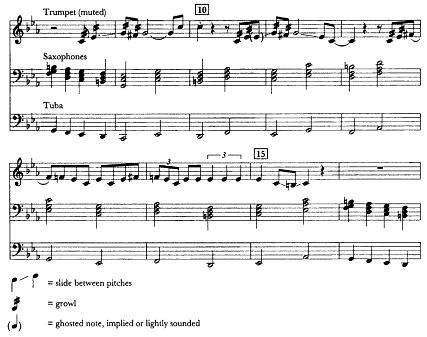
Example 19.
Duke Ellington and Bubber Miley, "East St. Louis Toodle-Oo," bars 8-16
(29 November 1926, Vocalion 1064; composite transcription after Gunther Schuller,
Early Jazz [New York, 1968], 327, and Mark Tucker, Ellington: The Early
Years [Urbana, Ill., 1991], 249)
tone sax, with the trombone section responding to Carney's rhythmicized pedal point.[48] Then, Juan Tizol on valve trombone plays a repeated riff—Schuller calls his sound "leathery, slithery"—responded to by the full saxophone section.[49]
Another kind of Ellington sound is found in a large family of pieces slow in tempo, rich and often chromatic in harmony, meditative in mood, of which the most famous is "Mood Indigo." In "Dusk" (ex. 22), after Ellington's piano introduction, the theme is played by a closely voiced trio: muted trumpet with the tune, muted trombone in the middle, and clarinet on the bottom, as in "Mood Indigo." In performance, the trio surrounds the mike and plays as one. The sound's impact lies perhaps as much in the intentness of listening that underlies such a delicate blend as in the notes themselves.[50]
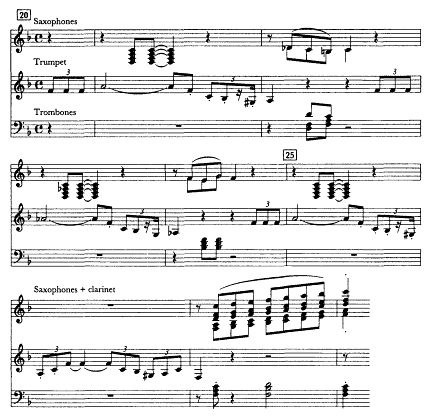
Example 20.
Duke Ellington, "Concerto for Cootie," bars 20-27 (15 March 1940, Victor 26598;
after Ken Rattenbury, Duke Ellington, Jazz Composer [New Haven, 1990], 183-85)
From this brief primer of Ellington sounds, let's move to some of his and his men's effects that can only be described as astonishing, both in conception and execution. "Braggin' in Brass," featuring the band's trumpet and trombone sections, begins with scurrying passagework for muted trumpets over the harmonies of the last strain of "Tiger Rag," an Ellington favorite. Then it's time for the trombones to brag. How does Ellington show them off? Through stinging attacks and a coordination that perhaps only Brown, Tizol, and Nanton, among trombone
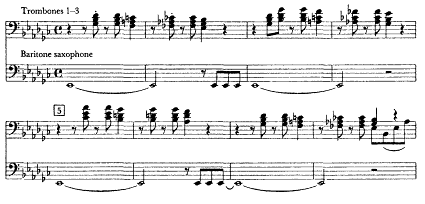
Example 21.
Duke Ellington, "Ko-Ko," bars 1-8 (6 March 1940, Victor 26577;
after Rattenbury, Duke Ellington, 107-10)
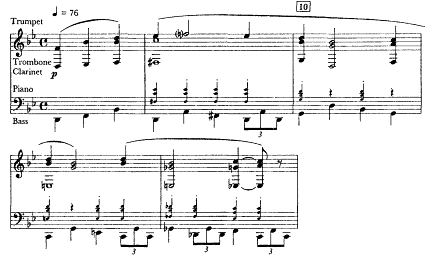
Example 22.
Duke Ellington, "Dusk," bars 8-12, (28 May 1940, Victor 26677;
after Gunther Schuller, The Swing Era [New York, 1989], 122)

(a) Chorus 2, bars 1-2, conflating three trombone parts into one line
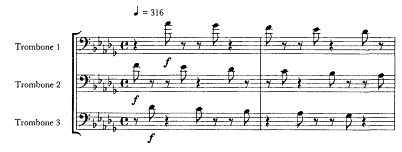
(b) Chorus 2, bars 1-2, showing the three trombone parts
Example 23.
Duke Ellington, Henry Nemo, and Irving Mills, "Braggin' in Brass"
(3 March 1938, Brunswick 8108; after Schuller, Swing Era, 94)
sections, could have managed. Ellington writes a descending broken chord figure whose notes look conventional enough on paper (ex. 23a). In performance, however, it's another story, for he divides the line so that each man plays only every fourth note (ex. 23b). Given the tempo—Schuller has clocked it at

"The New Black and Tan Fantasy" (1938) contains another marvel. Its third chorus is ostensibly a trombone solo by Nanton, with Ellington playing a stream of mysterious, parallel chords in lagging quarter-note triplets behind him. Further in the background, at least at the start of the chorus, is Barney Bigard's clarinet. At the very end of the preceding chorus, Bigard has swooped up to a high concert D-flat (the "blue" third in the piece's key of B-flat), which he sustains softly, without vibrato, like a tiny beam of light. As Nanton's solo unfolds with Ellington's backing, the D-flat begins to increase in volume and, ever so slowly, to rise in pitch. By the downbeat of bar 10, Bigard's note has blossomed
into a fortissimo F, a dominating dominant ringing high above the orchestra.[52]
Ellington sometimes took advantage of the freedom that introductions afforded. For there, whatever strangeness he wanted to hazard could be set forth audaciously, then jettisoned in favor of more conventional material when the main tune entered. "The Sergeant Was Shy" begins with a riff that was to be heard again in the novelty pop hit "Boogie Woogie Bugle Boy (from Company B)."[53] Ellington starts with clarinets playing that riff figure on B-flat in


But Ellington's music was not made to be swallowed in small doses. His mastery extended to musical form, and especially the short forms determined by the length of recordings of his day. I've chosen "Old Man Blues" (1930) to exemplify what we might call one-side form and "Diminuendo and Crescendo in Blue" (1937) for two-side form.
Bearing no relationship in its phrase structure or harmonies to the standard twelve-bar blues or its relatives, "Old Man Blues" shows Ellington's fondness for playing with musical form—for sparring with the listener through unexpected extensions, ellipses, and new melodic strains.[55] It also illustrates two other techniques that pervade Ellington's music. One is the quality of wordless singing that the plunger-mute technique produces, whether on trumpet or trombone. And this imitation of the voice, though a somewhat grotesque one bordering on the comic, leads one to hear many Ellington pieces or passages as conversations between instruments—often in the form of the call-and-response pattern that lies at the very heart of the blues. "Old Man Blues" is scored for three instrumental groups: the reed section (clarinets and saxes), the brass (trumpets and trombones), and the rhythm (piano, guitar, bass, drums). While Ellington's sections often play as units, a listener never knows when an individual voice will detach itself to comment on what other instruments are saying or singing.
TABLE 4 | ||
Formal function a | Featured instrument(s ) | Key |
I8 | soprano saxophone | E  |
A30 (aaba') | trombone and clarinet | |
B20 (vcd) |  | |
saxophone section (8) | ||
trumpet section (8) | ||
A32 | brass tune (16) | F |
trombone (8) | ||
brass tune (8) | ||
A32 | baritone saxophone and piano | |
brass backing on bridge | ||
A30 | soprano saxophone backed by | |
brass (16) | ||
trumpet (14) | ||
B10 (c'x) | saxophone section (6) | |
brass (4)  | ||
A32 | brass tune with clarinet swoops (16) | |
trombone and clarinet (8) | ||
brass tune (8) | ||
aI stands for intro; A, B for full thematic statements; a, b, c, d for parts of thematic statements; v for vamp; x for extension; and superscript numbers for the number of bars. | ||
After its introduction, "Old Man Blues" begins with such a conversation, though perhaps it would be better to call it a series of assertions by trombonist Nanton, around which clarinetist Bigard deftly dances. To borrow a line from a well-known poet, Bigard floats like a butterfly, while Nanton stings like a bee. "Old Man Blues" teems with unexpected details (see table 4). The second strain (B), for example, comes in two bars early both times it appears. The move from E-flat to F after the second strain is more a tonal ratcheting than a modulation, and by way of parallel fifths and octaves at that. The real tune isn't introduced until the second A section (A32 ). The trumpet solo in the fourth A section evokes a standard piece of stage business by beginning hopelessly behind the action and then catching up. And the brass section's break (x4 ) just before the last A is twice as long as expected.[56]
Even though the ending of "Old Man Blues," a ritard, sounds a bit stilted, the quality of playing on this recording is sharp, disciplined, crackling with excitement, and utterly convincing as an artistic statement.[57]
Ellington is renowned as one of the first jazz composers to explore "extended" form—that is, to write pieces too long to fit on one side of a ten-inch 78-rpm recording.[58] One such piece was "Diminuendo and Crescendo in Blue" (1937).[59] When Ellington composed this piece (actually a combination of two pieces, "Diminuendo in Blue" and "Crescendo in Blue," each written for one side of a 78-rpm record), there was no form in jazz more familiar than the twelve-bar blues, with its three four-bar phrases, its characteristic harmonic progression (moving from tonic to subdominant in bar 5 and to dominant in bar 9), and the implied call-and-response built into every phrase. Ellington's achievement in "Diminuendo and Crescendo in Blue" was to use this straightforward, conventional form, on which many of the musicians in his band could have improvised effectively, as the basis for a fanciful, beautifully shaped composition in which improvisation played only a small role. Ellington made his piece, of course, to be experienced from start to finish. But to appreciate the strangeness of its beginning, perhaps we should first discuss some of the work's simpler, more straightforward sections.
The fifth chorus of "Diminuendo" (bars 53-64)—one chorus of the twelve-bar blues pattern upon which the whole composition is based—features a call-and-response pattern operating in two-bar units. The trumpets give out an abrupt, two-beat call, and the saxes respond with a four-beat answer (ex. 24a). In the jazz tradition of Ellington's day, the chorus is the basic unit. And it is axiomatic that the harmonic progression of the chorus, tended by the rhythm section, recurs through a piece as its chief organizing force. When the chorus is as short as it is here—twelve bars at a brisk tempo—changes are most likely to occur from one chorus to the next rather than within choruses. That premise holds for "Diminuendo and Crescendo in Blue." In Chorus 6, the trombone section, silent in Chorus 5, takes the lead with a new melodic figure; the saxes respond, now in unison where before they had played four-part harmony (ex. 24b). In Chorus 7, short figures are replaced by a fully harmonized tune played by the saxes while the brass sit silent (ex. 24c).
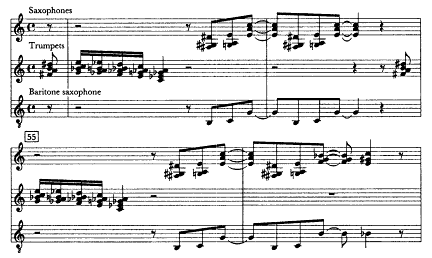
(a) Chorus 5, bars 1-4

(b) Chorus 6, bars 1-4
Example 24.
Duke Ellington, "Diminuendo in Blue" (20 September 1937, Brunswick
8004; manuscript in Smithsonian Institution, Duke Ellington Collection)
Sectional interplay has dominated Choruses 5-7; but the next three choruses feature soloists. First, trombonist Nanton, master of the sub-verbal growl, responds with hoarse mockery to the saxophone section's calls (Chorus 8). Then baritone saxophonist Carney fits his own responses into the windows in the trombone section's clipped chordal gestures (Chorus 9). And then Ellington himself plays a chorus that begins high and descends to a concluding cadence (Chorus 10). Through
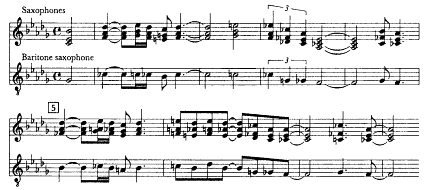
(c) Chorus 7, bars 1-8
Example 24.
(continued)
Choruses 5-10, colors have been gradually growing darker, the range moving downward, and the dynamic level decreasing. The trumpets do nothing important after Chorus 5. The key level has moved from the sharp side (G major) to the flat side (D-flat). Ellington has reached the end of the first half of his piece (and of side A of the disc on which it was first recorded). The "Diminuendo" is complete.
By now the "plot" of Ellington's "Diminuendo and Crescendo in Blue" is obvious enough, even if we have yet to discuss its beginning. Its shape is concave. Starting at peak level, intensity gradually subsides, all the way down to the pianissimo that ends the first half. Then the process is reversed. Table 5 shows a map of the "Crescendo in Blue," the piece's second half (side B). Among the striking features of its beginning is a brand new sound. Ellington's four reed players exchange their saxophones for clarinets, which they play with round, liquid fullness in the low-register unison tune that begins the "Crescendo" (ex. 25a). Behind them, the trombone section enters softly with dark, mahogany warmth. The unison tune, moreover, harks back to the lyric saxophone chorus heard in the "Diminuendo" (Chorus 7). And, as table 5 shows, its opening rhythmic motive recurs through the first three choruses of "Crescendo." One more thing sets off the beginning of the "Crescendo": Each of its first two choruses ends with a two-bar extension—Ellington's way of warning listeners away from complacent formal expectations.
TABLE 5 |
 |
au stands for unison; h stands for harmonized |
The fifth chorus of the "Crescendo" finds clarinets once more in the lead. But now they play a new, busier tune, and they are harmonized. Again, clarinets are answered by trombones, this time with a unison countermelody, which they phrase uncannily together, with the deftness of a single voice and the weight of three (ex. 25b). By Chorus 10, the orchestra is in full cry. The volume has been growing, chorus by chorus. The range has expanded, the melody rising to higher and higher registers. The brass join in on what's left of the thematic statement, now pared down to the briefest of motives (ex. 25c). In the gaps left by brass rests, clarinet responses are heard. And, as often happens toward the

(a) Chorus 1, bars 1-4

(b) Chorus 5, bars 1-12, trombone part

(c) Chorus to, bars 1-3
Example 25.
Ellington, "Crescendo in Blue" (20 September 1937, Brunswick 8004;
manuscript in Smithsonian Institution, Duke Ellington Collection)
end of Ellington's up-tempo numbers, one trumpet breaks loose from the others to fill the rest of the unclaimed space with screeching high notes. The texture has thickened; the instruments now play clusters of tones that are acidly discordant. Consonance is being overwhelmed by dissonance as the piece builds toward its conclusion.
With the full-throttle ending of Ellington's "Crescendo" in mind, let's go back and pick up the opening bars of the "Diminuendo." The music there, as expected, is loud, dense, and dissonant. But where the acrid pillars of sound with which the "Crescendo" climaxes are firmly and obviously embedded in the twelve-bar blues structure, the "Diminuendo" begins with less formal clarity. To recognize what Ellington is up to in these opening bars, it is worth recalling that in later parts of the work he follows both the standard harmonic structure and two more blues conventions as well. Ellington consistently begins the first two phrases of each twelve-bar chorus with a statement and restatement of the same melody. (The figure that begins bar x of a chorus also begins

Example 26.
Ellington, "Diminuendo in Blue," bars 1-4, melody
only (Smithsonian, Duke Ellington Collection)
bar 5.) And he relies heavily on call-and-response: the instrumental dialogue in which a statement by one voice is answered by another. These habits are missing from the beginning of "Diminuendo." In fact, through its first four choruses (bars 1-52), something is always out of kilter. In Chorus 1, it's the cross-rhythmic, athematic character of the material, coupled with a small glitch in the harmonic progression (ex. 26). Despite the theme's strident asymmetry, the blues structure could still be heard if the tonic chord returned in bar 11. But in bar 11, instead of rounding off the chorus, Ellington offers lurching, offbeat figures over some kind of F chord; the expected return to tonic E-flat is postponed until bar 12, leaving listeners with the feeling that a bar has been added, or at least that they've somehow lost their way.
The harmonic resolution at the end of a blues chorus usually fills two bars (bars 11-12), typically with one bar of tonic and one of dominant, which prepares for the tonic downbeat of the next chorus. But because the resolution at the end of Ellington's first chorus fills only one bar, bar 13, which starts Chorus 2, doesn't sound like the beginning that it is. Nevertheless, Chorus 2 gets under way with a call-and-response pattern: saxes and trumpets, densely packed, with the call, and unison trombones with the response (ex. 27). And in bar 5 of Chorus 2, the second phrase starts with the call repeated on the subdominant. So far, so good. In bar 6, however, instead of the active response heard in bar 2—and expected in the supposed restatement—we get from the trombones a sustained, stationary whole note. In bar 7 the call is repeated on the tonic. If it were repeated again in bar 9, we might still hear it within the twelve-bar blues framework, for the blues chord progression remains intact. But instead, bar 9 delivers new, confusing offbeat figures. The original call from bar 1 sounds again in bar 11. (Bars 11-14 of Chorus 2 repeat bars 1-4 almost exactly.) In retrospect, it's as if two new bars have been added to the melodic voices in bars 9-10, pulling them loose from the harmony. Or maybe bars 5-6 are the added ones.[60]
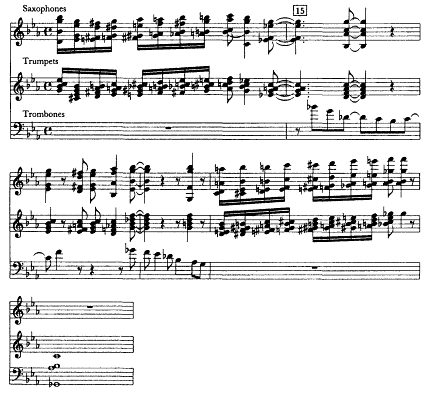
Example 27.
Ellington, "Diminuendo in Blue," Chorus 2, bars 1-6
(Smithsonian, Duke Ellington Collection)
In any event, even more than Chorus 1, the second chorus of "Diminuendo" leaves the listener disoriented, and especially so because it ends with a tag that carries the tonality from E-flat to G. Bars 27 and 28 of the piece prepare the listener for the next chorus.
On the downbeat of Chorus 3, the bass withholds the new tonic, clouding somewhat the new section's beginning. Ellington's material clouds the issue further. In a kind of role reversal, the brass call that begins the chorus sounds like a response—not a "melody" but a series of offbeat chords—and the sax section responds with a melodic statement more in the style of a call (ex. 28). Because the brass chords resemble the end of something more than the start, even a sharp ear
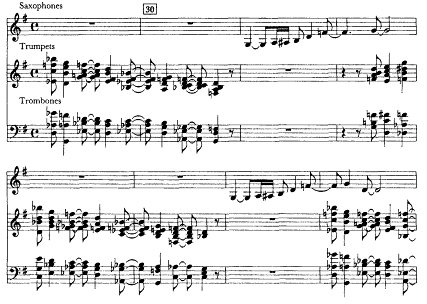
Example 28.
Ellington, "Diminuendo in Blue," Chorus 3, bars
1-8 (Smithsonian, Duke Ellington Collection)
could hear the saxes' entry with their tune (bar 3) as Chorus 3's beginning. However, when the subdominant arrives two bars later, repeating the opening brass chords, we learn belatedly that we're hearing a restatement. By bar 7, when the sax melodic response returns, the ear has regained its place in the form, only to have it dislodged in bar 8 by the entrance of the brass call—one bar early. And that call returns in bar 11, keeping the ear formally at sea until the chorus's end.[61]
In bar 41 of the "Diminuendo," Ellington finally delivers a clear-cut beginning: an arrival on the tonic, as expected, with a fresh new melodic figure beginning in the saxes on the downbeat (ex. 29). But it takes him only four bars to resume his undermining tactics. In Chorus 4's second phrase (bar 5), instead of the sax melody's restatement, a new figure is heard from the brass. The saxes answer with a response in kind, itself a restatement. Once again, however, the absence of a restatement in bar 5 contradicts the listener's expectations, so that it is not until Chorus 5, which puts the pieces of the blues puzzle together "correctly," that the blues form's conventions finally establish themselves.
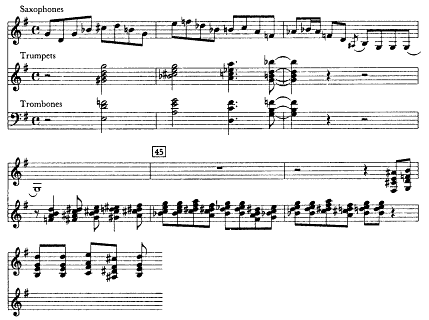
Example 29.
Ellington, "Diminuendo in Blue," Chorus 4, bars 1-7 (Smithsonian,
Duke Ellington Collection)
Barney Bigard once said of Ellington: "At first, just after I joined Duke . . . I used to think everything was wrong, because he wrote so weird."[62] The opening of "Diminuendo and Crescendo in Blue" illustrates that side of Ellington, showing a capacity for obfuscation and formal play far beyond what his audience expected or his vocation as a dance band leader required. "Diminuendo" is, on the one hand, another of Ellington's adventurous introductions, like "The Sergeant Was Shy" but on a larger scale. At the same time, it's a commentary on the nature of the twelve-bar blues as an instrumental form. In each of the first four choruses, the ingredients of the standard blues form are there: the chord progression, the call-and-response pattern, and the principle of statement and restatement. Yet, by changing some element in each—by delaying a harmonic arrival point, by switching the expected ordering of melodic statements or the character of calls and responses, or by adding measures—Ellington sows seeds of doubt in his listeners. Are we, in fact, hearing standard blues choruses or aren't we? We can't
be sure, at least not until Chorus 5 arrives. Thus, "Diminuendo in Blue" moves from dissonance to consonance, from loud to soft, from density to spareness, from rhythmic disruption to smoothness, and from formal opaqueness to formal clarity. Once the structure is clearly established at the start of bar 53, the ear shifts its focus from form to the flow of events—changes in texture, sound, time intervals between calls and responses, melodic invention—leaving the rather frequent modulations as the only unusual feature. Beginning on a manic note of disconnection, as if Ellington were a cubist painter probing the shape of the blues structure by pulling its pieces apart, then fitting them back together in unexpected ways, the piece settles into a groove, hits a point of calm relaxation, and then reverses the process. And it is unified not only by the harmonic progression that underlies all twenty-two of its choruses but by the melodic motive that begins the "Diminuendo," that returns in the seventh chorus in the saxes as the start of a longer melody, that begins the "Crescendo" and is heard through its first three choruses, and that reappears at the beginning of both Chorus 8 and Chorus 11 of that section.
I think Ellington's "Diminuendo and Crescendo in Blue" is an artistic success by any measure.[63] The strong first impression it makes gets stronger with more listenings. Unity and variety are well balanced. The composer's melodic invention seems fully up to the task. The music communicates on the levels both of fine detail and broad gesture, and the overall shape is there not just to be discovered analytically but to be experienced through the ears and body. Within a framework of relaxed spontaneity, the performance is polished and precise. We can feel comfortable calling Ellington's "Diminuendo and Crescendo in Blue" an excellent piece of music by an American composer of first rank.
One of the more admirable values of Western culture is its respect for works of art and the customs of preservation and connoisseurship that keep masterworks available to the public. In music, the chief means of accomplishing this are familiar: making and disseminating scores, giving concerts, and recording performances. While all lovers of music can think of pieces, even repertories, they wish were more readily available through these means, a great deal is within our reach already. And we who are curious about music from other times and places tend to assume
that the masterworks of almost any tradition will be available to us.
But for a long time, Ellington's "Diminuendo and Crescendo in Blue" escaped the musical world's preservationist net. A score? We now know that Ellington's short score and parts are preserved in the book of his now-defunct orchestra. But until the Smithsonian Institution purchased these materials and established its Ellington Collection in the late 1980s, the only access performers and scholars had to most of Ellington's music was through transcriptions of his recordings—an option open only to those with sharp ears, a profound knowledge of the style, and lots of time. (Even after a transcription was made, copyright and performance restrictions would hinder its ready circulation.) Concert performances? By whom? It's true that jazz repertory ensembles are being formed and do exist, especially (though not exclusively) in colleges and conservatories. But they need scores. Recordings? Here "Diminuendo and Crescendo in Blue" would seem to be on safe ground, since that's the form in which it was first offered to the public in 1937. "They" wouldn't let a great American piece like this get lost in the shuffle, would they?
Even here we can't be too sure. At the time this chapter was first drafted (in the winter of 1985), Ellington's 1937 recording of "Diminuendo and Crescendo in Blue" was not commercially available. (That situation has now been remedied, for this performance appears in the revised edition of the Smithsonian Collection of Classic Jazz. ) In fact, one of my anxieties as I prepared to lecture in public on Ellington was that somehow, in recording my examples, I would erase the dubbing from the tape sent me by a friend, leaving me without access to any recording at all. The precariousness of the existence of "Diminuendo and Crescendo in Blue," and of other masterpieces in its tradition, dramatizes a key point. Ellington worked in a commercial music business where salable performances were the commodity. The fate of his music, then, and, though to a lesser extent, even now, has depended, as Gushee has written, not "on the judgment of history nor of an elite of musicians, arrangers, teachers and critics" but rather reflects "the realities of selling phonograph recordings."[64]
In Ellington's drive to be "the best"—the competitive fire that propelled his "journey" as an American professional musician—the encountered no foe more intractable or persistent than the cultural "cat-
egories" against which he spoke and wrote from the time a public forum was available to him. The reach of Ellington's ambition made his life as a competitor especially complex. As a bandleader he competed against other leaders for employment. As a composer he competed, as all composers do, against the inherent difficulty of communicating with listeners through a sounding, nonverbal medium. And as an African-American artist, he battled attitudes that judged people and art by their fancied place in a network of categorical classifications: race, formal education, cultural prestige. No better emblem of his skill as an illusionist exists than the spirit in which he waged the latter struggle. As in other things, he staked out a position on high ground—not the familiar territory of "prejudice," about which many Americans held fixed positions, but the less explicit terrain of "category," free of political taint and bearing an air of philosophical detachment. (Did any of Ellington's interviewers ask him what, exactly, he meant by "category"?) Then, using an often gnomic style of expression drawn from home, school, poolroom, and the Bible, he denounced categories: the human propensity to overgeneralize and underestimate, to classify rather than respond. On racial discrimination in the United States, for example, he held strong feelings. Yet, understanding that the Declaration of Independence and the U.S. Constitution embody an ideal of social equality, he embraced without hesitation his identity as an American. As a man of the theater in its broadest sense, he believed that "a statement of social protest in the theater should be made without saying it."[65] His own career undermined and overthrew cultural categories at every turn. Black musicians of Ellington's generation were not called "Duke," didn't play in Carnegie Hall, didn't compose "extended works," and didn't receive honorary degrees or invitations to be fêted at the White House. Ellington did all of those things, mindful that, in the categorical world of American culture, his personal achievements might carry reverberations that would change the way Americans thought about American music—might, perhaps, even help to ease some of the restrictions under which other African-Americans led their lives. He was certainly right about the former. For today, rather than placing in a lesser category all musicians who pursue accessibility and broad commercial acceptance, historians and critics are more likely to find the commercial framework unworthy of some of the great figures who have toiled within its limitations. (Gunther Schuller sometimes writes of Ellington this way.)[66] In
such an ambience, "the realities of selling phonograph recordings" becomes a jejune detail, which indeed it may appear to be in the reordered world that Ellington helped to create.
Today we are free to declare record sales and popular acceptance dead issues and to say of Ellington, in effect, "now he belongs to the ages." But to take that position, to treat the world of popular entertainment in which he lived and excelled simply as an inhibiting force on his art, is to risk underestimating one of his primary achievements as an American artist. Living his professional life in a world devoted to ephemera—to fads, the pursuit of pleasure, and musical means (improvisation, recordings rather than scores, distribution of music by commercial hawking) geared to immediate economic gain—Ellington left an enduring legacy, both as a man and a composer. His personal achievement deserves the honor that it now is beginning to receive. It also testifies that, as noted in earlier chapters, in American music the need for "accessibility" does not always overwhelm artistry. Perhaps Ellington did spend his life overcoming artistic limitations his profession imposed on him; but in the course of that effort, by having to be concise and to create an impact or a mood immediately, he also gained needed discipline and skill that other composers might envy.[67] Rather than decrying commercial influence, we might do better to think of how Ellington turned it to his artistic advantage. Here, as elsewhere, we encounter the extraordinary blend of private and social, of independence and collaboration, that characterizes his music-making. The inner drive to be the best, coupled with the knowledge that only by creating a unique social network could he be the best in the way he wished, is another such instance. Thus the chapter title, "Duke Ellington and His Orchestra," like the tale of his life's journey, is intended to suggest the pull of opposing forces that somehow, in his hands, were reconciled—a kind of magnetic field in which (individual) inspiration is realized through the (collaborative) execution of musicians who, though nominally under his direction, are left firmly in control of their own "tonal personalities."
As Ellington grew older, he was invited more and more often to think of himself as transcending the world of present-day concerns in which his professional life had always been lived.[68] Here, for example, are two exchanges from the seventy-four-year-old composer's autobiography:
Q: | Which of all your tunes is your favorite? |
A: | The next one.[69] |
Q: | Is there satisfaction in knowing that what you have created gives you a chance to live and be known beyond your time? |
A: | I have no interest in posterity.[70] |
There's that Ellington persona again. Perhaps we should take his professed indifference to us no more at face value than the sunniness of his autobiography—or than the assumption that the lightheartedness of much of his music's surface and the circumstances of its creation mean that it's superficial music.[71] In the years since his death Ellington has been enshrined on the Mount Rushmore of American musical heroes. Songs like "Satin Doll" and a Broadway revue like Sophisticated Ladies , coupled with the vast Ellington iconography and the Ellington legend, are enough to maintain his presence before the public. But let's not be misled by that smiling presence. Behind it, Ellington and his music lie like a submerged subcontinent that is only now beginning to be seriously explored. I can think of no tougher scholarly challenge in the field of American music than such an exploration, nor, at the same time, any task that promises to shed more light on the question of what, in the broadest terms, it means to be an American composer.
7
George Gershwin's "I Got Rhythm" (1930)
Thanks to Ira Gershwin, we know something about the making of the song "I Got Rhythm." The year was 1930, and the Gershwin brothers were at work on the score of Girl Crazy , their next Broadway show. George had presented Ira with the music for the new song, leaving it to him to come up with lyrics. (Ira once wrote about his craft that since most of his lyrics "were arrived at by fitting words mosaically to music already composed, any resemblance to actual poetry, living or dead, is highly improbable.")[1] The chorus of the song George gave Ira, based on a syncopated four-note figure (ex. 30), was cast in standard thirty-two-bar AABA form with a two-bar tag.
Ira struggled with the lyric. "Filling in the seventy-three syllables of the refrain wasn't as simple as it sounds," he later recalled. "For over two weeks I kept fooling around with . . . sets of double rhymes for the trios of short two-foot lines," that is, with the rhyme scheme aaab/cccb. Here's Ira's illustration of the kinds of rhymes he first tried to write:
Roly-Poly,
Eating solely
Ravioli,
Better watch your diet or bust.
Lunch or dinner,
You're a sinner.
Please get thinner.
Losing all that fat is a must.
Yet, no matter what series of double rhymes . . . I tried, the results were not quite satisfactory; they . . . [gave a] jingly

Example 30.
George Gershwin, "I Got Rhythm," chorus, melody only,
bars 1-8 (Girl Crazy [1930])

Example 31.
George Gershwin, "I Got Rhythm" (Ira Gershwin),
chorus, melody with words, bars 1-8
Mother Goose quality to a tune which should throw its weight around more.
Ira solved his problem only after he began to try nonrhyming lines. "This approach felt stronger," he recalled, "and finally I arrived at the present refrain (the rhymed verse came later), with only 'more—door' and 'mind him—find him' [as] the rhymes. Though there is nothing remarkable about all this, it was a bit daring for me who usually depended on rhyme insurance." Ira also explained that he did not write "I've got rhythm" but borrowed the verb's "most colloquial form,"
the one used for the present tense instead of "have," and the one going back to my childhood: e.g., "I got a toothache" didn't mean "I had a toothache," but only "I have" one. . .. Obviously, I've got nothing against "I've got" since the verse ends with "Look at what I've got." [But] . . . the musically less assertive and regularly rhymed verse seems to require the more conventional phrasing.[2]
In the finished song, Ira used the four-note figure to list life's valued possessions (ex. 31).
Girl Crazy opened on 14 October 1930.[3] It told the story of a collection of New Yorkers and San Franciscans, transplanted to the one-horse town of Custerville, Arizona, who succeed in bringing high city life with them, including a bevy of Broadway beauties.[4] The part of "Frisco" Kate Fothergill, wife of a gambling-room manager, was given to a newcomer, the twenty-one-year-old Ethel Merman, and it was she who introduced "I Got Rhythm" to the public. Although Merman's performance was a high point in the show, she didn't record the song until much later in her career. In a spoken introduction to a commemorative recording, Merman told the story of "I Got Rhythm" and her debut as a Broadway star.
Once upon a time, back in 1930, I stepped out on stage at the Alvin Theater in New York, got hit in the kisser with a big spotlight, and found myself in big-time show business.[5] It was in a thing called Girl Crazy , which boasted Ginger Rogers, Willie Howard, and the DeMarcos,[6] and a great score by George Gershwin. One of the songs I did that memorable night was "I Got Rhythm." And as I riveted the second chorus I held on to a high C like it was from Tiffany's, and the last one in the world.[7] Anyway, it was a show-stopper. It sort of launched me on my way, so I guess you can't blow the whistle on me for saying it's one of my special favorites. It goes like this. And brother, how it goes![8]
When Merman published her autobiography in 1955, it was called Who Could Ask for Anything More?
The projection and energy of Ethel Merman's performance was not the only reason "I Got Rhythm" proved a show-stopper in Girl Crazy . For in the Broadway theater of that day, it was customary to turn the pit orchestra loose with hot "ride-out" choruses at the ends of peppy, up-tempo numbers like this one. Among the members of the band that played at the Alvin Theater during the show's run were musicians who must have waited eagerly for such moments and made the most of them when they arrived. The band had been formed by Red Nichols, a twenty-five-year-old cornetist who had already gained a reputation in jazz circles for recordings with the group Red Nichols and His Five Pennies. It also included several others who were soon to make their mark in the world of swing: reedman Benny Goodman (age twenty-one), drummer Gene
Krupa (twenty-one), trombonist Glenn Miller (twenty-six), and trumpeter Charlie Teagarden (seventeen).[9] Because Goodman, Krupa, and Merman stayed before the public for many years, they may now be remembered as grandparently figures. It's well to recall how young and close to the beginnings of their careers they were when they first performed "I Got Rhythm"—a fresh new tune by a songwriter not much older than they were.
As noted in earlier chapters, from the time of the eighteenth century, with a composer like Alexander Reinagle, through the nineteenth, with Foster, Root, and others, and on into the early twentieth, American popular music circulated chiefly as sheet music designed for home performers. But in 1920 a printer's strike and a paper shortage caused production costs to triple,[10] and almost overnight the phonograph recording replaced sheet music as the chief means of popular music's circulation.[11] Numbers tell the story. During one seventy-five-week period beginning in 1922, a song by Irving Berlin, "Say It with Music," sold 375,000 printed copies—a healthy amount but barely a tenth as large as the 3.5 million sold by Ray Egan and Richard Whiting's "Till We Meet Again" in just a few months of 1918. Berlin's "Say It with Music" was nevertheless a hit. By what measure? By its sale during the same seventy-five weeks of x million records and 100,000 piano rolls.[12] In 1930, Broadway shows, with their capacity for plugging songs during long runs in New York and through traveling companies, were one of the sheet-music industry's chief moneymaking properties, with publishers investing in shows to obtain the copyrights of their songs.[13] A Broadway show like Girl Crazy thus aimed at success on two fronts: as an evening's entertainment for an audience in a theater and as a source of songs that could be published, recorded, and marketed individually, regardless of the show's fate.[14] Thus, as with other Broadway shows of the time, the music publishing and recording industries hovered over the beginning of Girl Crazy in hopes of finding new Gershwin songs they could turn into gold.[15]
And now a word about the composer.[16] The career of George Gershwin (1898-1937) as a professional musician began in 1914, when he quit school to work as a song-plugger on New York's Tin Pan Alley. In 1919, he composed his first score for a Broadway show, La, La, Lucille , and the song "Swanee," recorded in 1920, became his first bona fide hit.[17] In 1924 Gershwin became famous. He did so not by writing successful
musicals or more hit songs but by composing and performing, with great public fanfare, in a concert organized by dance-orchestra leader Paul Whiteman, a piece recognized instantly as historic. The piece was Rhapsody in Blue for piano and orchestra. Premiered in New York's Aeolian Hall on 12 February, the Rhapsody owed much of its impact to the circumstances in which it was introduced. Whiteman's concert, billed as "An Experiment in Modern Music," had been designed to show that jazz, the new, vivacious, audience-pleasing dance music that most concert musicians and critics of the time associated with poor musicianship, could please cultivated tastes when performed in the "symphonic" arrangements that were the Whiteman band's specialty. And Gershwin's Rhapsody , billed as a "jazz concerto," testified that jazz-based music need not be confined to pieces of pop-tune length. With questions about the identity and destiny of American music very much in the air, with critics like Carl Van Vechten and Gilbert Seldes arguing that the American fine arts of the future would be vitalized through vernacular idioms, and with Whiteman personally inviting prominent classical musicians and New York's leading critics to the performance, the Aeolian Hall concert achieved a sense of occasion.[18] Gershwin's Rhapsody won the audience's approval and the critics' attention. It also won renown for its composer. No longer simply another talented American songwriter, he was now recognized as a historical figure: the man who brought "jazz" into the concert hall.
After the success of the Rhapsody , Gershwin's life as a composer changed. He continued to write for the musical theater, though at a somewhat slower pace.[19] But he gave more and more of his energy to concert music; and he continued to study composition, as he had since 1917, his teachers including Edward Kilenyi, Rubin Goldmark, Walling-ford Riegger, Henry Cowell, and Joseph Schillinger. He managed this broadening of his musical activities and interests without sacrificing public appeal or fame. Rather than shrinking from success, Gershwin reveled in it, accepting praise calmly as no more than his due. By 1930, when he wrote Girl Crazy , Gershwin stood unmatched among American composers in his combination of eminence and range, not to mention the power to command resources for anything he decided to compose, and to attract an audience as well.[20]
"I Got Rhythm" occupied a special place in Gershwin's work. It was the song he himself singled out as best suited for embellished
instrumental performance. In George Gershwin's Song Book (1932), which contained eighteen Gershwin songs in his own arrangements for piano, "I Got Rhythm" was one of only two songs—"Liza" was the other—for which he supplied two choruses rather than one. In its strict observance of the notated rhythm, Gershwin's arrangement pays tribute to the song's instrumental pedigree. Singers have tended to loosen the declamation to something closer to a half note and quarter note:

Now let's go back to October 1930. Within ten days of the opening of Girl Crazy on the 14th, three significant recordings of "I Got Rhythm" were made. On the 20th, Freddie Rich, conductor of the CBS Radio Orchestra, recorded it with a group under his own name. On the 23d, Red Nichols and His Five Pennies—all thirteen of them, and including Goodman, Krupa, Miller, and other members of the Girl Crazy pit band, plus vocalist Dick Robertson—made their own version. And on the 24th, one of New York's best black bands, Luis Russell and His Orchestra, recorded another version. Each can be taken to represent the beginning of a different approach to Gershwin's number: (1) "I Got Rhythm" as a song played and sung by popular performers; (2) "I Got Rhythm" as a jazz standard , a piece known and frequently played by musicians, black and white, in the jazz tradition; and (3) "I Got Rhythm" as a musical structure , a harmonic framework upon which jazz instrumentalists, especially blacks, have built new compositions.
Let's begin with the song. I noted Ira Gershwin's struggle to find a rhyme scheme fitting George's tune. But I said nothing about the words
he finally wrote. William Austin has pointed out that the Gershwin brothers used the word "rhythm" in several of their songs. In 1918 Ira called ragtime "a rhythmic tonic for the chronic blues."[23] In 1924 he wrote: "Fascinating rhythm, it'll drive me insane";[24] in 1928, "Listen to the rhythm of my heart beat";[25] in 1930, "I Got Rhythm"; and in 1937, "Today you can see that the happiest men/All got rhythm."[26] Austin adds: "I believe the Gershwins are largely responsible for [the word] rhythm entering the vocabularies of millions of people for whom it had previously been too technical."[27] The two Gershwin songs with "rhythm" in the title are both built on syncopation. "Fascinating Rhythm" from 1924, sung by a character obsessed with an off-center rhythmic pattern, divides its first four bars, in effect, into measures of four, three, five, and four beats. As for "I Got Rhythm," of the seventeen lines in the lyrics of its chorus, thirteen are set to the same four-note figure, a rhythmic cell that hits only one of the four strong beats in the two bars it covers. For Ira Gershwin the lyricist, "rhythm" in this song was tied up with aggressive, accented, syncopated groupings of beats.
But Ira's lyrics are not really about rhythm in the way that those of "Fascinating Rhythm" are. They're an expression of general well-being. Rhythm and music are linked with "daisies in green pastures," with "starlight," "sweet dreams," and being in love. The message here is that "the best things in life are free"—incidentally the title of a hit song from the Broadway show Good News (1927).[28] Merman's performance was an outpouring of high spirits, saying, most of all, "I feel wonderful! " Her sustained "high C" through the A sections of the second chorus—we can imagine outstretched arms and a multikilowatt smile—is the opposite of a celebration of rhythmic trickiness.
As a show-stopping song and vehicle for a new and vibrant theatrical talent, "I Got Rhythm" could hardly have been more successful. But as a popular song independent of the show, its success was more modest. "I Got Rhythm" called for a kind of vocal energy that few popular singers of Gershwin's day possessed. The first "jazz" recording, made by Freddie Rich with Paul Small as vocalist six days after Girl Crazy opened on Broadway, follows the sheet music straightforwardly and attempts neither to match Merman's exuberant interpretation nor to bring out the snap of Gershwin's syncopation. Its emotional blandness is matched by that of a version recorded the same day by Victor Arden
and Phil Ohman, a duo-piano team whose orchestras had played in the pit of many Gershwin shows. (Frank Luther sang on this recording.)[29] A 1938 performance by singer Jane Froman reinstates the full-throated, high-spirited Merman approach with the help of a Schubertian running figure in the violins.[30] There is a 1943 recording, from a film version of Girl Crazy , in which Judy Garland restores "rhythm" as an issue by conscientiously singing the syncopations that Gershwin wrote.[31] And when Mary Martin sang "I Got Rhythm" for a reconstruction of the show in the 1950s, the accompaniment in her second chorus was reduced to percussion, supporting the text's first line literally as well as figuratively.[32]
To these two distinctive approaches to "I Got Rhythm"—the Merman exuberance and the Garland/Martin beat—we can add another that turns the song into a novelty number in a theatrical context far removed from Custerville, Arizona. Vincent Minelli's film, An American in Paris (1951), weaves Gershwin's music into a story of romantic love in the City of Lights. In one scene Gene Kelly, playing a young American, conducts an English lesson on the streets of Paris for a group of French boys. Spoken dialogue leads into the song:
KELLY : | Parlez anglais à nous? Ecoutez. Je suis le professeur . |
BOYS : | [general laughter] |
KELLY : | Répétez après moi . Door. |
BOYS : | Door! [shouted] |
KELLY : | Street. |
BOYS : | Street! |
KELLY : | Lady. |
BOYS : | Lady! |
KELLY : | Window. |
BOYS : | Window. |
KELLY : | Allons maintenant. Une chanson américaine . An American song. |
BOYS : | Oooo!! [exclamation of wonder and anticipation] |
KELLY : | Dites-moi . I got. |
A BOY : | I got! |
KELLY : | Bon! Tous ensemble! |
BOYS : | I got! |
KELLY : | Bon . [whistles two-bar introduction] |
An antiphonal performance of the chorus of Gershwin's song follows, with students shouting and teacher singing. Armed with their newly learned English phrase, the boys respond individually to Kelly's prompting with eager cries of "I got," often delivered well before the beat. The performance is a reminder that "I Got Rhythm" is a "list song" depending more on incantatory repetition than on rhyme or verbal ingenuity.
A BOY : | I got! |
KELLY : | . . . rhythm, |
A BOY : | I got! |
KELLY : | . . .music, |
A BOY : | I got! |
KELLY : | . . . my gal, |
Who could ask for anything more? | |
A BOY : | I got! |
KELLY : | . . . daisies, |
A BOY : | I got! |
KELLY : | In green pastures, |
A BOY : | I got! |
KELLY : | . . . my gal, |
Who could ask for anything more? |
(After singing the bridge section, which is free of "I got"s, Kelly asks: Vous comprenez ça? , to which one boy shoots back: Non! )[33] So the Gershwins' "I Got Rhythm" could be a song about aggressive joyfulness, or syncopated rhythmic drive, or teaching kids how to speak American.[34]
Now let's consider "I Got Rhythm" as a jazz standard. We've already noted that jazz performers were among those who first played Gershwin's song in public, and Red Nichols's recording shortly after the show's premiere was the first of dozens in the jazz tradition. Table 6 carries a list, taken from Brian Rust's jazz discography.[35]
In the jazz tradition, we usually speak of tunes, not songs. A jazz tune is defined first and foremost by its structure: by the pattern of
TABLE 6 | ||
Performer b | Date | Recording company |
Fred Rich & Orch (v) | 20 Oct 1930 | Columbia |
Red Nichols & Five Pennies (v) | 23 Oct 1930 | Brunswick |
Luis Russell & Orch (v) | 24 Oct 1930 | Melotone |
Fred Rich & Orch (v) | 29 Oct 1930 | Harmony, OKeh |
Ethel Waters (v) | 18 Nov 1930 | Columbia |
Cab Calloway & Orch (v) | 17 Dec 1930 | ARC; rejc |
Adelaide Hall with piano (v)/ | Oct 1931 | Oriole |
Louis Armstrong & Orch (v)/ | 6 Nov 1931 | OKeh |
Billy Banks (v; medley) | 13 April 1932 | Victor test |
Bobby Howes (v)/London | 10 May 1932 | Columbia |
Roy Fox & Band (v)/London | 19 May 1932 | Decca |
Blue Mountaineers (v)/London | 18 June 1932 | broadcast |
Don Redman & Orch | 30 June 1932 | Brunswick |
Ray Starita & Ambassadors (v)/ | 12 Aug 1932 | Sterno |
* New Orleans Feetwarmers (v): | 15 Sept 1932 | Victor |
* Joel Shaw & Orch (v): "Yeah | Oct 1932 | Crown |
Arthur Briggs & Boys (v)/Paris | ca. June 1933 | Brunswick |
* The King's Jesters/Chicago: | 29 July 1933 | Bluebird |
* Fletcher Henderson & Orch: | 18 Aug 1933 | Vocalion, Brunswick |
Spirits of Rhythm (v) | 29 Sept 1933 | ARC; rej |
Five Spirits of Rhythm (v) | 24 Oct 1933 | Brunswick |
Freddy Johnson & Harlemites/ | ca. Oct 1933 | Brunswick |
Freddy Johnson & Harlemites/ | 7 Dec 1933 | Brunswick |
Casa Loma Orch | 30 Dec 1933 | Brunswick |
* Jimmy Lunceford & Orch: | 29 Oct 1934 | Decca |
(continued ) | ||
(table continued on next page)
TABLE 6 | ||
Performer b | Date | Recording company |
* Chick Webb's Savoy Orch: "Don't | 19 Nov 1934 | Decca |
Joe Venuti & Orch | 26 Dec 1934 | London (LP) |
Stéphane Grappelli & Hot Four/ | Oct 1935 | Decca |
* Nat Gonella & Georgians (v)/ | 20 Nov 1935 | Parlophone |
Garnet Clark (piano)/Paris | 25 Nov 1935 | HMV |
Fats Waller & Rhythm (v) | 4 Dec 1935 | HMV |
* Chick Webb & Orch: "Don't Be | Feb 1936 | Polydor (LP) |
Red Norvo & Swing Sextette | 16 March 1936 | Decca |
The Ballyhooligans (v)/London | 2 April 1936 | HMV |
Joe Daniels & Hot Shots/London | 15 July 1936 | Parlophone |
* Count Basie & Orch: "Don't Be | ca. Feb 1937 | Vanguard |
Jimmy Dorsey & Orch/Los | 3 March 1937 | Decca |
Lionel Hampton & Orchd | 26 April 1937 | Victor |
Benny Goodman Quartet | 29 April 1937 | MGM |
Glenn Miller & Orch | 9 June 1937 | Brunswick |
Count Basie & Orch | 30 June 1937 | Coil. Corner |
Dicky Wells & Orch/Paris | 7 July 1937 | Swing |
Valaida [Snow] (v)/London | 9 July 1937 | Parlophone |
Chick Webb & Little Chicks | 21 Sept 1937 | Decca |
Emilio Caceres Trio | 5 Nov 1937 | Victor |
Scott Wood & Six Swingers (medley)/London | 12 Nov 1937 | Columbia |
Benny Goodman Quartet | 16 Jan 1938 | Columbia |
* Benny Goodman & Orch: "Don't | 16 Jan 1938 | Columbia |
Bud Freeman Trio | 17 Jan 1938 | Commodore |
* Lionel Hampton & Orch: "Don't | 18 Jan 1938 | Victor |
* Benny Goodman & Orch: "Don't | 16 Feb 1938 | Victor |
(continued) | ||
(table continued on next page)
TABLE 6 | ||
Performer b | Date | Recording company |
* Ozzie Nelson & Orch/ | 5 March 1938 | Bluebird |
* Mildred Bailey & Orch (v): "Don't | 14 March 1938 | Vocalion |
* Jimmy Dorsey & Orch: "Don't Be | 16 March 1938 | Decca |
* Teddy Wilson & Orch: "Don't Be | 23 March 1938 | Brunswick |
Larry Adler with Quintette of | 31 May 1938 | Columbia |
* Gene Krupa & Orch: "Wire | 2 June 1938 | Brunswick |
* Johnny Hodges & Orch: "The | 24 Aug 1938 | Vocalion/OKeh |
Louis Armstrong & Fats Waller (v) | 19 Oct 1938 | Palm Club |
Clarence Profit Trio | 15 Feb 1939 | Epic |
* Erskine Hawkins & Orch: "Raid | 8 April 1939 | Bluebird |
* Earl Hines & Orch: "Father Steps | 12 July 1939 | Bluebird |
* Tommy Dorsey & Orch: "Stomp it | 20 July 1939 | Victor |
* Count Basie's Kansas City Seven: | 5 Sept 1939 | Vocalion |
* Earl Hines & Orch/Chicago: | 6 Oct 1939 | Bluebird |
Benny Goodman Sextet (medley) | 24 Dec 1939 | Vanguard |
Caspar Reardon (v) | 5 Feb 1940 | Schirmer |
Count Basie & Orch/Boston | 20 Feb 1940 | Coil. Corner |
Fletcher Henderson & Horace | 27 Feb 1940 | Vocalion |
* Duke Ellington & Orch/ | 4 May 1940 | Victor |
Sid Phillips Trio/London | 6 May 1940 | Parlophone |
* Count Basie & Orch: "Blow Top" | 31 May 1940 | Epic |
Max Geldray Quartet/London | 26 July 1940 | Decca |
(continued ) | ||
(table continued on next page)
TABLE 6 | ||
Performer b | Date | Recording company |
* Coleman Hawkins & Orch: | summer 1940 | [LP reissue] |
Felix Mendelssohn & Hawaiian | 28 Oct 1940 | Columbia |
* Johnny Hodges & Orch/Chicago: | 2 Nov 1940 | Bluebird |
* Duke Ellington & Orch/Fargo, | 7 Nov 1940 | Palm |
* Johnny Hodges & Orch/ | 3 July 1941 | Bluebird |
Metronome All-Star Leaders | 16 Jan 1942 | Columbia |
a Contrafacts—i.e., newly titled tunes with new melodies based on the harmonic structure of "I Got Rhythm"—are indicated by an asterisk; their titles are listed with the performers' names. | ||
b Unless otherwise indicated, location is New York; v denotes inclusion of vocal. | ||
c Here and elsewhere, "rej." identifies a rejected take: a recording that was not commercially issued. | ||
d As "Rhythm, Rhythm." | ||
e Not listed in Rust. See John Chilton, The Song of the Hawk: The Life and Recordings of Coleman Hawkins (Ann Arbor, Mich., 1990), 180. | ||
repetition and contrast in its melodic phrases and the harmonic framework underlying them. Second, it is defined by its ethos: by the mood it projects and the tempo at which it is played. Only third does its melody come into play, for in the jazz tradition the melody is often little more than an entrée into the performance; after being heard, it is usually discarded for free melodic invention by the performers. The chorus of "I Got Rhythm" follows one of the most common Tin Pan Alley song forms: statement, restatement, contrast, and return, with the contrast being called the "bridge" or "release." We could diagram the form as AABA', the first three phrases filling eight bars and the fourth ten, by virtue of the two-bar extension. Gershwin's harmony is as elemental as his melody. The latter is cast in two-bar units, with the four-note syncopated cell moving up, then down, then up again, and then breaking the pattern with a cadence. The harmony supports these gestures with a parallel pattern: three I-ii7 -V-I loops followed by a I-V-I cadence.
Or perhaps it would be better to describe Gershwin's harmonic framework that way, as Gunther Schuller does,[36] noting that the published song actually employs a more varied and colorful sequence of chords:
B
B6 | Cm7 F7 | B6 Edim | Cm7 F7 |
B
B6 | Cm7 F7 Em6 | BF7 | BC#dim F
Ira Gershwin liked George's tune's ability to "throw its weight around." The "weight" of "I Got Rhythm" as Gershwin wrote it stems partly from tempo and syncopation but perhaps even more from economy of material—from the song's avoidance of tonal complexity or variety. The song's first melodic statement (A) dwells on B-flat; its restatement (A), in what is virtually a note-for-note repetition, does the same; the release (B) jumps to the relative minor, then wends its way back through the circle of fifths; and the return (A1 ) restates the beginning, again note-for-note, softening the austerity a bit with a concluding tag. The classic simplicity of the song's harmonic design summoned jazz performers' inventiveness, both melodic and harmonic, to a degree matched by only one other structure in the history of jazz: the twelve-bar blues. But even before discussing jazz performances, it is well to recall the impression George Gershwin's music for "I Got Rhythm" made upon Ira Gershwin and Ethel Merman, two people far removed in sensibility from the world of jazz. Ira's response as a lyricist was a list of abrupt, colloquial claims ("I got . . ."); Merman found as a singer that one sustained note could replace the Gershwin brothers' first six bars, to the vast delight of the Girl Crazy audience. Both, in short, discovered in George's music a certain bare, even abstract quality—one that an Alec Wilder might consider as a weakness in a popular song[37] but that, within the genre of the up-tempo instrumental number, proved astoundingly able to unlock jazz musicians' inventiveness.
From the many available jazz-style performances of "I Got Rhythm," I've chosen three for brief discussion here. The first, from 1937, is played by the Glenn Miller Orchestra (ex. 32). This is Miller's band before it settled into the formulas that were to. make it a huge commercial success; and since Miller had known the tune when it was brand new, his arrangement from seven years later carries special interest. If one accepts

Example 32.
George Gershwin, "I Got Rhythm," bars 1-8, played by
Glenn Miller and His Orchestra (9 June 1937, Brunswick 7915)
the premise that a jazz arrangement is a commentary upon—even a kind of analysis of—the original tune, Miller's first chorus confirms his view that Gershwin's melody line leaves something to be desired. Melodic interest here lies more in the reed countermelody composed by Miller than in Gershwin's original, played staccato in the brass. Miller's recording suggests how most jazz instrumentalists performed "I Got Rhythm": as an up-tempo flag-waver, a piece consistently played fast, and hence a kind of test piece, putting the group, and especially the improvising soloist, on trial.[38] Later in Miller's arrangement is a striking effect that shows his band at the peak of its rhythmic drive. Discarding not only Gershwin's melody but his harmony too, Miller here reduces the first six bars of Gershwin's A section to virtually nothing but rhythm and sound. Twice the band crescendos on one note, played on alternate eighths by the brass and reed sections and sweeping listeners (or dancers) ahead like a canoe in white water.[39]
A notable recording from the mid-1940s testifies to the place of "I Got Rhythm" in the jazz repertory by that time. The scene was New York's Town Hall on the evening of 9 June 1945. The audience had gathered, but by concert time only two musicians had shown up, tenor saxophonist Don Byas and bass player Slam Stewart. What to do? Give the customers back their money and send them home? Not that night. Byas and Stewart set out on a voyage over some jazz standards, and "I Got Rhythm" was the second number they played. Their performance, up-tempo and obviously unrehearsed, confirms our sense of Gershwin's song as a vehicle for virtuosic melodic play over familiar harmonic ground. After paraphrasing Gershwin's melody (without the original two-bar extension), Byas improvised four fluent inventive choruses,
stood by while Stewart soloed in his patented style of bowing the bass and singing (through clenched teeth, an octave above), then followed with four additional choruses that explored Gershwin's tune further.[40]
Also noteworthy is a recording made by pianist Art Tatum with guitar and bass accompaniment at around the same time, and at breakneck speed. Tatum is known for technical virtuosity and unmatched harmonic imagination. He is also known as a melody player—one who respected the original tune and tended to keep it within earshot even during his improvised choruses.[41] In "I Got Rhythm," however, Tatum flashes only a hint of Gershwin's melody, then gives it up completely in the second chorus. Tatum's recording, from the mid-1940s, also confirms a trend that had already begun in the 1930s in performances of "I Got Rhythm": that of embellishing the ii-V-I chord progressions in Gershwin's A sections with richer harmonies. In his last two choruses, Tatum begins each of the eight-bar A sections on an F-sharp seventh chord—enhar-monically G-flat, or the flat sixth degree—and then moves downward through the circle of fifths in a succession of half notes until, at the beginning of the fifth bar, he reaches the B-flat tonic in which the piece is rooted. (The harmonic progression is: F-sharp7, B7, E7, A7, D7, G7, C7, F7, B-flat.)
Tatum's recording, which drapes Gershwin's scaffold with fresh harmonic material, brings us to the third approach performers took to "I Got Rhythm."[42] As early as 1932, with Sidney Bechet's recording of a tune he called "Shag," black jazz musicians had begun to invent new melodies on the structure of Gershwin's song, abandoning his tune entirely and renaming their versions as new compositions.[43] Fletcher Henderson's "Yeah Man" from August 1933 is another example, as is "Stomp It Off," recorded by Jimmie Lunceford in October 1934.[44] And so is Chick Webb's "Don't Be That Way," from November of the same year.[45] This tune, by the way, adds to the story of Benny Goodman's relationship with Gershwin's song, for he and Edgar Sampson are named as co-composers. The melody of "'Don't Be That Way," a tune that Goodman played at his Carnegie Hall concert in January 1938, and that began the recording issued long after the event, is shown in example 33.[46]
The long list of tunes based on the chord progression of "I Got Rhythm" includes recordings by tile best swing bands, such as Count Basie's "Blow Top" from 1940 anti Woody Herman's "Apple Honey"

Example 33.
Edgar Sampson and Benny Goodman, "Don't Be That Way," bars 5-12, melody
only, played by Chick Webb and His Orchestra (19 November 1934, Decca 483)
from 1945.[47] In "Cotton Tail" (1940), Duke Ellington wrote three memorable strains to Gershwin's chords.[48] First, the lean explosive melody of the first chorus, played by saxes in unison and one muted trumpet (ex. 34a). Second, a sixteen-bar statement for the brass in which Ellington manages, without establishing a predictable pattern, to create a powerful sense of rhythmic coherence (ex. 34b). Finally, Ellington composes a thirty-two-bar melody—not Gershwin's AABA but ABCD—for the sax section in full harmony (ex. 34c).[49]
The so-called bebop revolution of the early 1940s broke decisively with the swing era in many things. But one tradition it carried on and even intensified was the practice of making new tunes on the chord progressions of older ones. Each of the most prominent black swing bands—Count Basie, Duke Ellington, Erskine Hawkins, Fletcher Henderson, Earl Hines, Jimmie Lunceford, Chick Webb, as well as groups featuring major soloists like Johnny Hodges and Lester Young—had its own version of "I Got Rhythm" as a standard vehicle for up-tempo "blowing." So too did many bebop musicians. The reasons were partly artistic, partly social, but they were also economic. Drummer Max Roach has been quoted as saying:
Of course there are about ten million tunes written on the changes of "I Got Rhythm." . . . This wasn't pilfering. In cases where we needed substitute chords for these tunes, we had to create new melodies to fit them. If you're gonna think up a melody, you'd just as well copyright it as a new tune, and that's what we did. We never did get any suits from publishers.[50]
Few bebop musicians after World War II played "I Got Rhythm" as a jazz standard. But as a key,[51] a tempo, a structure, and an occasion for virtuosic improvisation, it was deeply engrained in the jazz repertory, even when its harmonic scheme was embellished with remote chords.
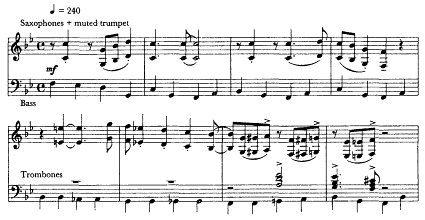
(a) Bars 1-8

(b) Chorus 4, bars 1-16, rhythm only

(c) Chorus 5, bars 1-8, melody only
Example 34.
Duke Ellington, "Cotton Tail," played by Duke Ellington and His Orchestra
(4 May 1940, Victor 26610; after Gunther Schuller, The Swing Era [New York, 1989], 127)
TABLE 7 | |||
Name | Recording Date a | Copyright Date | Copyright |
"Red Cross" | 15 Sept 1944 | 17 Sept 1945 | EU439039 |
"Shaw 'Nuff"c | 11 May 1945 | 11 Nov 1948 | EP32267 |
"Thriving from | 26 Nov 1945 | 1 Dec 1945 | EU449251 |
"Anthropology"c | March 1946 | 13 Aug 1948 | EP29445 |
"Moose the | 28 March 1946 | 1 Nov 1946 | EU51928 |
"Bird's Nest" | 19 Feb 1947 | 20 April 1961 | EU656872 |
"Chasing the Bird" | 8 May 1947 | 20 Jan 1948 | EU112914 |
"Dexterity" | 28 Oct 1947 | 20 April 1961 | EU65181 |
"Crazeology" | 17 Dec 1947 | 21 Aug 1961 | EU672281 |
"Constellation" | 18 Sept 1948 | 15 Nov 1948 | EU148835 |
"Ah-Leu-Cha" | 18 Sept 1948 | 15 Nov 1948 | EU148840 |
"Steeplechase" | 24 Sept 1948 | 15 Nov 1948 | EU148831 |
"Passport" | 5 May 1949 | 1 June 1953 | EU318785 |
"An Oscar For Treadwell" | 6 June 1950 | 20 March 1967 | EU431242 |
"Swedish | 8 Aug 1951 | 26 March 1956 | EU431248 |
"Kim" | 30 Dec 1952 | 1956; 3 Jan | EU431245 |
"Celerity" | none given | 19 March 1958 | EU517086 |
a Recording dates from Brian Priestley, Charlie Parker , Jazz Masters series (Tunbridge Wells, England, 1984). | |||
b EU means unpublished copyright; EP means published copyright. | |||
c Co-composer with Dizzy Gillespie. | |||
And bebop musicians, like their predecessors, sought ownership in the tradition that Gershwin's show song had begun.
No one in the jazz tradition was more closely identified with the "Rhythm changes" than alto saxophonist Charlie Parker, who returned again and again to the structure of Gershwin's tune throughout his career, composing at least seventeen different pieces based upon it, many of which were picked up, played, and recorded by other jazz performers (table 7). The harmonic structure of "I Got Rhythm" won

Example 35.
Charlie Parker, "Red Cross," bars 4-12 (15 September 1944, Savoy 532)

Example 36.
Charlie Parker, "Steeplechase," bars 1-8 (September 1948, Savoy 937)
a place in Parker's imagination, much as the theme of the Eroica Variations or perhaps Diabelli's Waltz had in Beethoven's—though Beethoven concentrated his efforts on lengthy, integrated compositions, while Parker's "I Got Rhythm" variations are scattered widely among many performances. Following is a quick trip through Parker's Sax-Übung , pieced together from recordings made between 1944 and 1950.[52]
Gershwin's "Rhythm changes" inspired Parker to compose several different kinds of variations upon them. The most old-fashioned of the three employs the riff style, in which a melody is built up by repeating one brief melodic motive (ex. 35). Parker's process of abstraction here reduces the A section's harmony, except for bar 6, to a B-flat tonic chord. (In the release, however, a new riff based on Gershwin's chord changes appears.) In 1948 Parker composed a new riff for the A section, leaving the bridge free for improvisation. He called this piece "Steeplechase" (ex. 36).
The riff approach establishes a context of regular predictability as a launching pad for the improvisation that follows. But Parker's second

Example 37.
Charlie Parker, "Moose the Mooche," bars 9-16 (28 March 1946, Dial 1003)
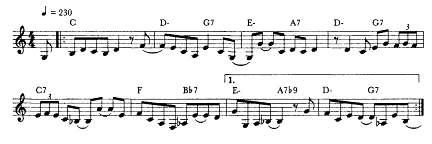
Example 38.
Charlie Parker, " An Oscar For Treadwell," bars 8-16 (6 June 1950,
Verve MGV800)
approach does the opposite. "Moose the Mooche," for example, is an invention for unison duet—alto sax and muted trumpet—that is rhythmically asymmetrical, broken into irregular phrases by rests in unexpected places (ex. 37). And "An Oscar for Treadwell" (ex. 38) is built in a similar way, with phrases of four beats, eight beats, fifteen beats, and five beats in its first eight bars. Its bridge is free.
Finally, Parker employed the "I Got Rhythm" chord changes to create a kind of obstacle course that only the best players could negotiate. Bassist Milt Hinton once explained how Parker, Dizzy Gillespie, and other bebop pioneers would discourage players who wanted to join their after-hours jam sessions at Minton's in Harlem during the early 1940s
"What're y'all gonna play?" [they'd ask.] We'd say, "I Got Rhythm," and we'd start out with this new set of changes and they would be left right at the post. They would be standing

Example 39.
Charlie Parker and John "Dizzy" Gillespie, "Shaw 'Nuff," bars 24-32
(11 May 1945, Guild 1002)
there, and they couldn't get in because they didn't know what changes we were using, and eventually they would put their horns away, and we could go on and blow in peace and get our little exercise.[53]
"Shaw 'Nuff" (ex. 39) shows this approach. Played at top speed, it also changes harmony every two beats. Intimidation is the name of the game here—intimidation of any neophyte with the gall to try to join such a performance.
From Parker's heyday in the years just after World War II, many bebop players—Thelonious Monk, Art Pepper, Miles Davis, Sonny Rollins, Sonny Stitt, Bud Powell, and Fats Navarro among them—created their own new tunes on Gershwin's chord changes.[54] And some of these new tunes themselves became standards. Ellington's "Cotton Tail" totaled more than thirty recordings in the years 1943-68, and Parker and Gillespie's "Anthropology" logged nearly twenty more in the same period.[55] Moreover, the steady stream of "I Got Rhythm" variants that flowed through the 1950s had the effect of updating the tune so that when, for example, drummer Art Blakey featured the young trumpeter Wynton Marsalis in a performance of "The Theme" in 1981, half a century after "I Got Rhythm" first saw light of day, it did not sound anachronistic.[56]
Gershwin's song "I Got Rhythm" is an especially good example of what I've referred to earlier as "performers' music": music composed and published with the expectation that performers, rather than being bound by a composer's score, will change melody, harmony, tempo, or
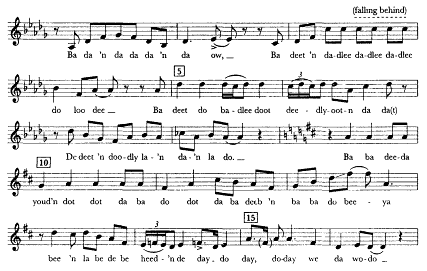
Example 40.
George Gershwin, "I Got Rhythm," Chorus 2, bars 1-16, melody only, sung by Ella
Fitzgerald with orchestra conducted by Nelson Riddle (1958-59, Verve VE-2-2525)
mood as they see fit, thus putting upon it the stamp of their own musical personalities.[57] "I Got Rhythm" attracted an unusually wide range of treatments from performers, flourishing in several different traditions of performance. These traditions are documented not in musical notation but in commercially produced phonograph recordings.
It seems appropriate to end this chapter with a comment on a performance that combines elements of the different traditions that made Gershwin's song their own. The singer is Ella Fitzgerald, accompanied by a sizable orchestra.[58] The presence of the verse, which is seldom sung, and a string section, helps to remind us that we're dealing, after all, with a song from a Broadway show by Gershwin . The introduction in the first chorus of a swinging beat and big band sound celebrates the song's pedigree as a jazz standard. But what kind of jazz standard? Ella Fitzgerald, a big band singer since 1935, knew full well the tradition of instrumental performance that lay behind "I Got Rhythm" when she made this recording in 1959. And the beginning of her second chorus (ex. 40) with sixteen bars of wordless scat-singing—clearly the musical
climax of this performance[59] —can be heard as a tribute to the countless trumpeters, pianists, sax players, and guitarists, from the time of Red Nichols and Luis Russell, through Ellington, Parker, Gillespie, and beyond, for whom Gershwin's song, or his tune, or his harmonic structure, or all three, marked out a territory in which artistic capacities were tested and honed and realized—a territory in which artistic truth was to be sought and found.







